ORIGINAL RESEARCH article
Sustainable development for film-induced tourism: from the perspective of value perception.

- 1 School of Business and Trade, Nanchang Institute of Science & Technology, Nanchang, China
- 2 Media Art Research Center, Jiangxi Institute of Fashion Technology, Nanchang, China
- 3 Guangdong University of Finance and Economics, Guangzhou, China
- 4 Department of Art Integration, Daejin University, Pocheon, South Korea
- 5 School of Business, Foshan University, Foshan, China
- 6 College of Management, Shenzhen University, Shenzhen, China
- 7 School of Economics and Management, East China Jiaotong University, Nanchang, China
The tourism economy has become a new driving force for economic growth, and film-induced tourism in particular has been widely proven to promote economic and cultural development. Few studies focus on analyzing the inherent characteristics of the economic and cultural effects of film-induced tourism, and the research on the dynamic mechanism of the sustainable development of film-induced tourism is relatively limited. Therefore, from the perspective of the integration of culture and industry, the research explores the dynamic mechanism of sustainable development between film-induced culture and film-induced industry through a questionnaire survey of 1,054 tourism management personnel, combined with quantitative empirical methods. The conclusion shows that the degree of integration of culture and tourism is an important mediating role that affects the dynamic mechanism of sustainable development of film-induced tourism, and the development of film-induced tourism depends on the integration of culture and industry. Constructing a diversified industrial integration model according to local conditions and determining the development path of resource, technology, market, product integration, and administrative management can become the general trend of the future development of film-induced tourism.

Introduction
As an emerging industry, cultural tourism can make up for the economic difficulties caused by the weak growth of the primary and secondary industries, and replace it as a new driving force for economic growth ( Liu et al., 2021b ). As recognized by both the academic community and industry, cultural tourism products greatly impact tourism destination development; souvenir, local cuisines, and films/television programs can promote tourism destinations ( Liu et al., 2021a , b ). Among them, film/television is the most influential form of art in today’s society. Film and television can help potential tourists to have some sensory and emotional cognitions through empathy and vicarious feeling to the tourist destinations mentioned in the films ( Kim and Kim, 2018 ; Pérez García et al., 2021 ), thereby generating tourism motivation and ultimately promoting tourism behaviors. Film and television, without exception, have integrated commerciality and artistry since birth, and form a unique form of culture ( Riley et al., 1998 ).
Hence, these significant economic effects have been widely investigated by researchers from different perspectives, such as promotion of local brands ( Liu et al., 2021a ), and changes in aesthetic information dissemination ( Kim et al., 2019 ). With in-depth studies, researchers have identified the profound connotation of the rapid development of film-induced tourism: the extension of the immersive tourism ( Marafa et al., 2020 ), the endowment of modern fashion labels for tourism destinations ( Teng and Chen, 2020 ), and multi-dimensional integrations of modern media technology and traditional entertainment industry.
Culture is the soul of tourism, and tourism is an important carrier of culture. Although the experience of film/television is different from tourism—the former is provided to people by means of image transmission, and the latter is realized by the way of people moving—but the essence is both cultural experience ( Syafrini et al., 2020 ; Senbeto and Hon, 2021 ). The connotation and the applied research of film-induced tourism reveal the complexity and diversity of the integrations of modern media and traditional entertainment.
The traditional glimmering style sightseeing tour is just a shallow taste, and often cannot make tourists get a deep enjoyment. Film-induced tourism is different, mature film-induced tourism products can bring tourists wholehearted relaxation and enjoyment, and make tourists’ self-worth better reflect. To clarify the inherent characteristics of film-induced tourism, the interactive observation of both the film and television subject and the tourism subject provides a feasible solution. Film/television programs are the expression and substantiveness of culture ( Yi et al., 2020 ). Tourism as an economic carrier is the pattern and standardization of the industry ( Yen and Croy, 2016 ). The development of film-induced tourism relies on the mutual integration of culture and industry.
With the evolution of the world, sustainable development is leading the way in every industry including tourism. The early understanding of sustainable development in the academic community refers to meeting the needs of the current generation without damaging the needs of future generations’ development ( Jabareen, 2008 ; Yi et al., 2021a ). Based on this concept, the United Nations has formulated 17 sustainable development goals, proposed new standards for the prosperity and development of the earth, and standardized the assessment methods and indicators for sustainable development ( Böhringer and Jochem, 2007 ; Hacking and Guthrie, 2008 ; Singh et al., 2009 ). Since then, the concept of sustainable development has been fully implemented and has gradually become a well-known concept from the perspectives of the environment, economy, and society ( Adedoyin et al., 2021 ; Diep et al., 2021 ; Zhou et al., 2021 ). Currently, these three dimensions are identified as the motivations and mechanisms of sustainable development ( Steffen et al., 2015 ; Svensson and Wagner, 2015 ). Specifically, challenges in sustainable development are vital issues for exploring social and economic development. Economic benefits are the main dynamics of continuous action ( Hoogendoorn et al., 2015 ), with social effects as the main motivation of practice ( Williams and Schaefer, 2013 ), and environmental effects as the basic assurances of all activities ( Halme and Korpela, 2014 ). Hence, sustainable development research help explore the path of the industry development. The dynamic mechanism of sustainable development builds the foundation for the long-term influence of the culture and provides the way for continuous development and expansion of industrial effects ( Waheed et al., 2020 ). At present, to the best of our knowledge, very few studies have investigated the dynamic mechanism of the sustainable development for film-induced tourism. The existing studies which include the sustainable development dynamic mechanism can be divided into three aspects:
(1) The macro sustainable development concept of film-induced tourism ( Wen et al., 2018 ); (2) The sustainable development concept in the exploration of film-induced tourism ( Gong and Tung, 2017 ; Teng, 2021 ); (3) The micro sustainable development concept of film-induced tourism ( Suni and Komppula, 2012 ). Afterward, most of the studies believe that the dynamic mechanism of sustainable development is affected by its resource development, innovation mode, or artistic attractions. However, these have not yet conducted a quantitative study of the endogenous interactions between culture and industry. Accordingly, we try to fill the research gap; we study the relationship between culture and industry in film-induced tourism through structural equation modeling to promote the sustainable development dynamics brought about the integration of culture and industry.
Literature Review
Film-induced culture and tourism industry.
Film-induced culture plays a vital role in the global advertisement system. It is an effective approach for the advertisement of regional values and soft power, and it is a good pathway for cultural output and value proposition ( Yi et al., 2020 ). With the advance of economic development, consumers have broken the restrictions of basic needs spending ( Sun et al., 2017 , 2021 ; Du et al., 2020 ), and the needs for higher-level cultural consumption are becoming increasingly important ( Wang et al., 2020a , b ; Li et al., 2021 ). Film-induced culture is by no means limited to entertainment culture, and film-induced products are by no means limited to spiritual and cultural consumer goods ( Chen, 2018 ). Film/television is also a mass media. Film-induced culture has an unprecedented impact on people’s ways of thinking, social cognition, behavioral habits, and values, showing unique cultural tension and becoming an important structure of people’s spiritual life ( Misra, 2000 ; Janssen et al., 2008 ). Otherwise, as a fast-growing important new tourism trend, film-induced tourism creates connections between characters, places, stories, and tourists, and is inspired to immerse themselves in films to relive film-generated and film-driven emotions ( Riley et al., 1998 ). Essentially, both film and tourism provide an opportunity to relive or experience, see and learn novelties through entertainment and fun ( Teng, 2021 ). Film-induced tourism increases the overall economic effect of tourism industry and establishes the bonds of film and tourism industry. It provides not only pleasure and satisfaction for film-induced tourists, but also adequate and novel learning experience. The latest research trends are moving toward merging or collaborating two fields that already have similar goals.
The integration of film-induced culture spreads information through film-induced programs to “maximize” the effect of tourism cultural brands ( Huang and Liu, 2018 ). The fundamental reason is that the penetration of film-induced culture has driven the transformation and upgrading of tourism consumption ( Michael et al., 2020 ), which in turn makes film-induced culture a resource for tourism development, amplifies the effect of cultural integration in the process of transformation, and further enhances the influence of the tourism industry ( Marafa et al., 2020 ). The establishment of film-induced cities and film-induced bases creates the advantages of film-induced culture agglomeration, and the innovative path of developing film-induced cultural resources oriented by the tourism industry is becoming more and more popular ( Ringle, 2018 ). Cultural resources are further optimized and reorganized, and film-induced culture will gain a series of new integrated development in the promotion of tourism industry model ( Xin and Mossig, 2017 ). On the one hand, the film-induced bases can be used for film/television production, and on the other hand, it is an important place for tourism activities, which truly reflects the integration from products, markets, enterprises, and industries in film-induced tourism industry ( Stuckey, 2021 ). Accordingly, some researchers believe that the establishment of Hollywood Studios in 1963 marked the official beginning of film-induced tourism. Hence, film-induced culture can promote the tourism industry to shape brand culture, integrate useful resources, guide consumer trends, and induce convergence effect for rapid development and innovation ( Wu and Lai, 2021 ). Hence, the following hypotheses are proposed:
H1a: The development of film-induced culture is positively related to the growth of the tourism industry.
H1b: The cultural development in film-induced tourism is positively correlated to the degree of cultural and tourism integration.
H1c: The development of the tourism industry is positively correlated to the degree of culture and tourism integration.
Culture and Tourism Integration and Sustainable Development
The integration of culture and tourism is not only the objective need for the mutual prosperity of culture and tourism, but also the inevitable trend of the development. The elements compete, cooperate and co-evolve with each other, so that an emerging industry can be formed, and it has experienced “grinding-integration-harmony” of the dynamic development process ( Jovicic, 2016 ; Wang and Yi, 2020 ). Culture and tourism have a certain basis for mutual benefit and cooperation: for tourism, the integration of cultural-related content helps to acquire extensive knowledge, distant experience, and strong care; for culture, it is conducive to the protection and inheritance of cultural resources, image building, and propagation ( Loulanski and Loulanski, 2011 ; Jørgensen and McKercher, 2019 ). The integration of culture and tourism is an intimate contact between “poems and dreams,” which better meets people’s diverse needs for a beautiful life ( He et al., 2021 ). However, sustainable development refers to comprehensive and sustainable advancements in ecological, social, and economic aspects. The cognition that based on these three goals can be used to explore the dynamic mechanism for sustainable development of film-induced tourism.
In the dimension of sustainable ecological development, with the advent of the scientific revolution and the industrial revolution, the world is entering a new era. The utilization of resources is not limited to the development of physical resources but is more prone to the rational use of new resources, such as talented person, technology, intelligence, and data ( Waheed et al., 2020 ; Zhang et al., 2020 ; Li et al., 2021 ), cultural resources, such as historical culture, red culture, and folk culture, are integrated with tourism resources, such as landscape pastoral, to develop complementary advantages. The maximization of resource utilization has become the key to the sustainable development of the film-induced tourism society, and culture has become a regulator of various innovation factors, which promotes the scientific management of technological and industrial resources ( Delai and Takahashi, 2011 ; Liu et al., 2021b ). When transforming and utilizing film-induced cultural resources, do not trample or destroy the ecological environment for tourism development, and comprehensively optimize the tourism environment and tourism routes. Environmentalism and related laws and regulations have begun to pay attention to tourists’ needs ( Li et al., 2020 ). Hence, the further integration of culture and tourism can reflect the transformation of the overall ecological commitment ( Zhou et al., 2021 ), and the resulting human–environment relationship has become a new aspect of sustainable development.
In the dimension of sustainable social development, on the one hand, the improvement of cultural quality of the whole society is a prerequisite for the organic integration of culture and tourism ( Tien et al., 2021 ), with harmonious coexistence becoming the core aspect of economic and cultural development of the new era, tourists and other stakeholders of the film-induced tourism industry begins to focus on human capital development, social recognition, job creation, and health and safety-related issues ( Choi and Ng, 2011 ). With the deepening of research, researchers found that the above-mentioned problems are ideologically attributed to culture and are the society’s force for inducing the sustainable development of industries ( Cai and Zhou, 2014 ). The extension and connotation of tourism need the guidance of tourism culture. Cultural display or visitable production expands the scope of displayable culture, from material to non-material, to the integration of non-material and material, and then to the contemporary creative cultural display, which makes culture continuously “commoditized” ( Silberberg, 1995 ; Marques and Pinho, 2021 ). At present, many scholars have reached a consensus that the integration of culture and industry can promote the construction of the social community ( Jakhar, 2017 ; Yi et al., 2021b ) and promote the relevant members of the society to change their misconduct, thereby strengthening the sustainable development of the film and television industry and the tourism industry.
In the dimension of sustainable economic development, scholars generally agree that economic factors, which refer to the renewable and non-renewable resources invested in the production process, are composed of factors, such as cost, profit, and business development ( Mamede and Gomes, 2014 ; Wagner, 2015 ). Given the direct impact of economic effect on tourist activities is significant, most researchers directly view economic factors as the main driving force for the sustainable development of film-induced tourism, owing to the direct influence of economic effects on tourists’ tourism activities ( Horbach et al., 2013 ; Hojnik and Ruzzier, 2016 ). As been defined by researchers, sustainable economic development involves the exploration and innovation of business models, creating market opportunities, the processes of resolving unsustainable environmental and social problems ( Schaltegger et al., 2016 ). When film-induced culture is continuously produced into cultural tourism products, the commercial interests of tourism sales promote the industrialization and gradually form a complete industrial chain-cultural tourism industry. In the studies of film-induced tourism, many researchers view film-induced culture as a resource for creating new business models and market opportunities and regard the integration of film-induced culture with the tourism industry as a solution for unsustainable development problems. In summary, in film-induced tourism, in both the ecological, social, and economic dimensions, the integration of culture and industry will influence the path of sustainable development. Hence, the following hypotheses are proposed:
H2a: The degree of integration between film-induced culture and the tourism industry is positively related to the sustainable development of the ecology (human–environment integration).
H2b: The degree of integration between film-induced culture and tourism industry is positively correlated to the sustainable development of the society (harmonious coexistence).
H2c: The degree of integration between film-induced culture and the tourism industry is positively related to the sustainable development of the economy.
Above all, we proposed the following effect hypothesis:
H3a: Film-induced tourism culture has a significant impact on sustainable development through integration degree;
H3b: Film-induced tourism industry has a significant impact on sustainable development through integration degree.
Methodology
To get a better and professional understanding of the dynamic mechanism of the culture and industry associated with film-induced tourism, the research subjects are limited to the management staff of the film-induced tourism industry. A total of 1,200 questionnaires were distributed, and 1,054 valid questionnaires were collected, with a recovery rate of 87.8%. The collected questionnaires were randomly divided into two equal sets (527 questionnaires in each set): one dataset is used for exploratory factor analysis and the other is used for confirmatory factor analysis. The demographic characteristics of the sample population are shown in Table 1 . From Table 1 we can see, most of the responders are males (accounting for 68.9%), in the age groups of 25–35 and 36–45 (the total number of the two age groups accounting for 65.3%) and have a bachelor’s degree (accounting for 54.9%). 28% of the responders are tourism area managers; 34.7% of the responders are government department managers; and 37.3% of the responders are general staff. And the demographic characteristics of the responders generally follow the demographic distribution of the entire population in the area, indicating a good representativeness of the data and makes it an effective data source.
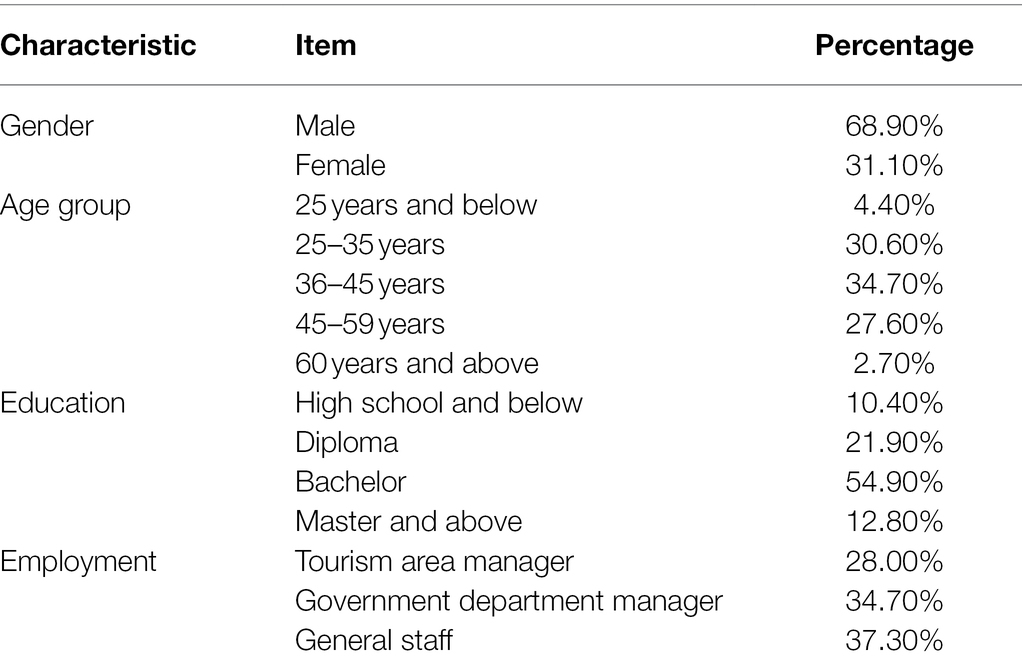
Table 1 . Sample basic information.
We draw on the mature scales used in previous studies for reference, and the initial scale was formed after corresponding modifications according to research topic. Then, two scholars who have been engaged in film-induced tourism and sustainable development were invited for analysis and discussion, and the scale was modified and improved. We use 5-level Likert scale to measure all variables, with 1 indicating “very unimportant” and 5 indicating “very important.” The specific measurement items and reliability are shown in the appendix. In addition, SPSS 26.0 was used for validity test, and KMO was 0.906 (>0.8). The results show that the scale has good reliability and validity, indicating that there is internal consistency among the variables ( Table 2 ).
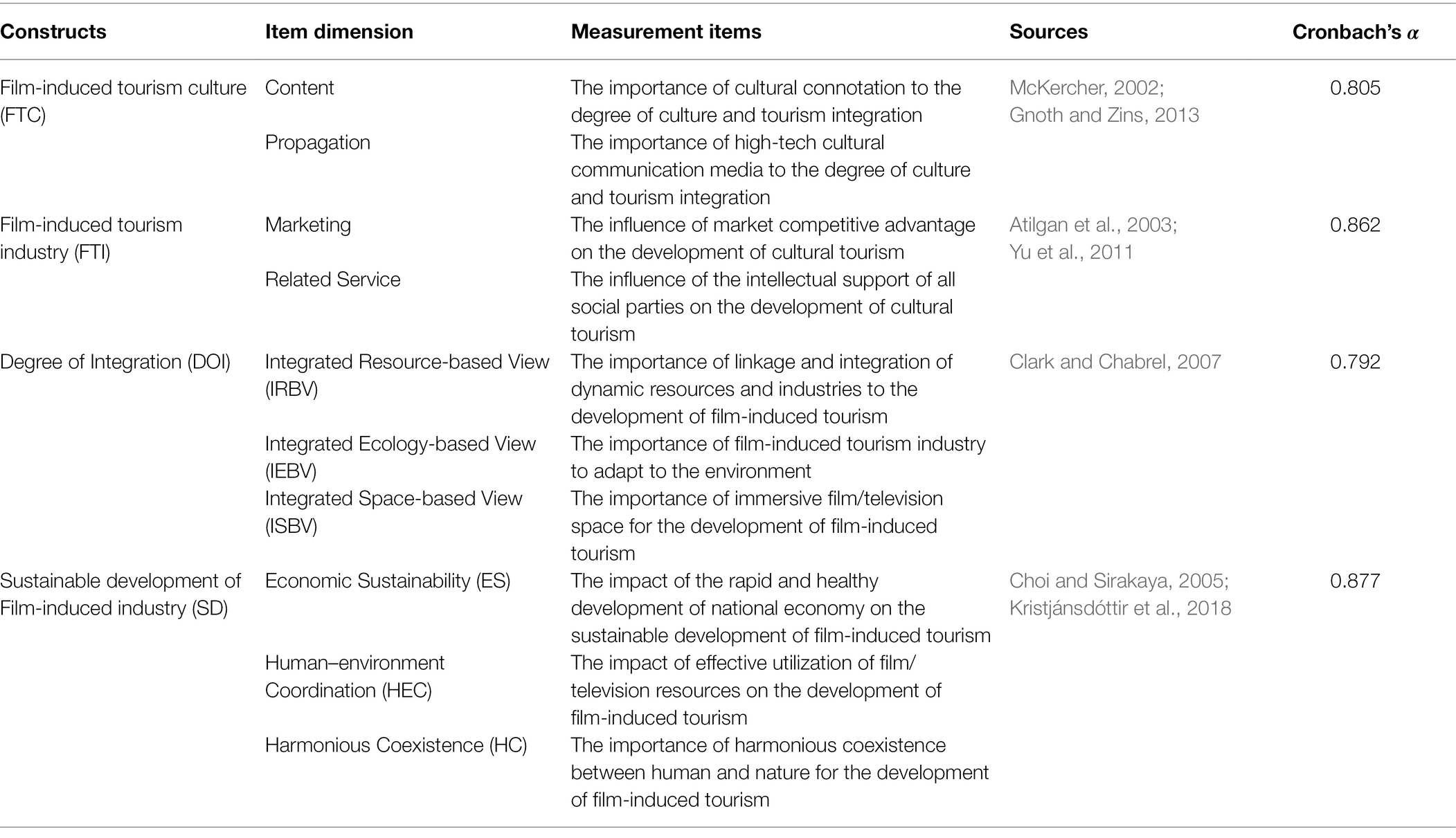
Table 2 . Measurement items and reliability.
Confirmatory Factor Analysis
Confirmatory Factor Analysis (CFA) showed ( Table 3 ) that P<0.01, and the Composite Reliability of all variables was 0.622–0.865, so that the polymerization validity and the convergence validity is good. AVE was in a reasonable range. Therefore, the results of CFA all meet the standard, and all dimensions have good convergence validity.

Table 3 . Confirmatory factor analysis.
Correlation Analysis
Through the correlation coefficient test, it can be seen that the values below the diagonal are, respectively, the correlation coefficients between potential variables ( Table 4 ). Each potential variable has different connotations in theory, and each variable has relatively high correlation and good discriminant validity.

Table 4 . Correlation analysis.
Goodness of Fit of the Structural Model
Based on the previous research results, the path relationship diagram between potential variables and observed variables has been built, the goodness of fit of the model to be verified have been tested from AMOS 26.0. The main fitting indicators all meet the ideal standard, that is, the model fitting effect is ideal.
Hypothesis Testing
In order to further test the hypothesis proposed above, we run a structural equation model with mediation (see Figure 1 ). The results are shown in Table 5 . There is a correlation between film-induced culture and film-induced industry ( r = 0.720). Film-induced culture has a significant impact on the degree of integration ( r = 0.590, C R = 7.495, p < 0.01); The film-induced tourism industry has a significant impact on the degree of integration ( r = 0.441, C R = 6.326, p < 0.01), then hypothesis 1a, 1b, 1c are supported. The degree of integration has a significant positive impact on film-induced tourism ( r = 0.836, C R = 11.817, p < 0.01), so hypothesis 2a, 2B, and 2C are also supported.

Figure 1 . Structural equation model. FTC, film-induced tourism culture; FTI: film-induced tourism industry; DOI, degree of integration; SD, sustainable development of film-induced industry; IRBV, integrated resource-based view; IEBV, integrated ecology-based view; ISBV, integrated space-based view; ES, economic sustainability; HEC, human–environment coordination; HC, harmonious coexistence.
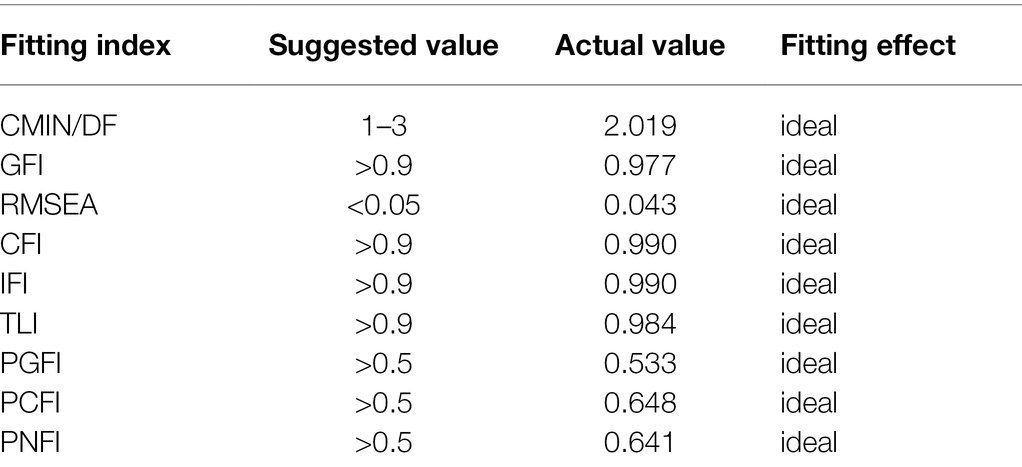
Table 5 . Goodness of fit of the structural model.
Empirical Testing of Mediating Effects
In order to test the reliability of the path hypothesis, we further use Bootstrapping to calculate the mediating effect of culture and tourism integration. Bootstrapping test performs 3,000 samplings and selects a 95% confidence interval, then the final test results are shown in Table 6 , so both hypothesis H3a and H3b are assumed to hold ( Table 7 ).

Table 6 . Hypothesis testing.
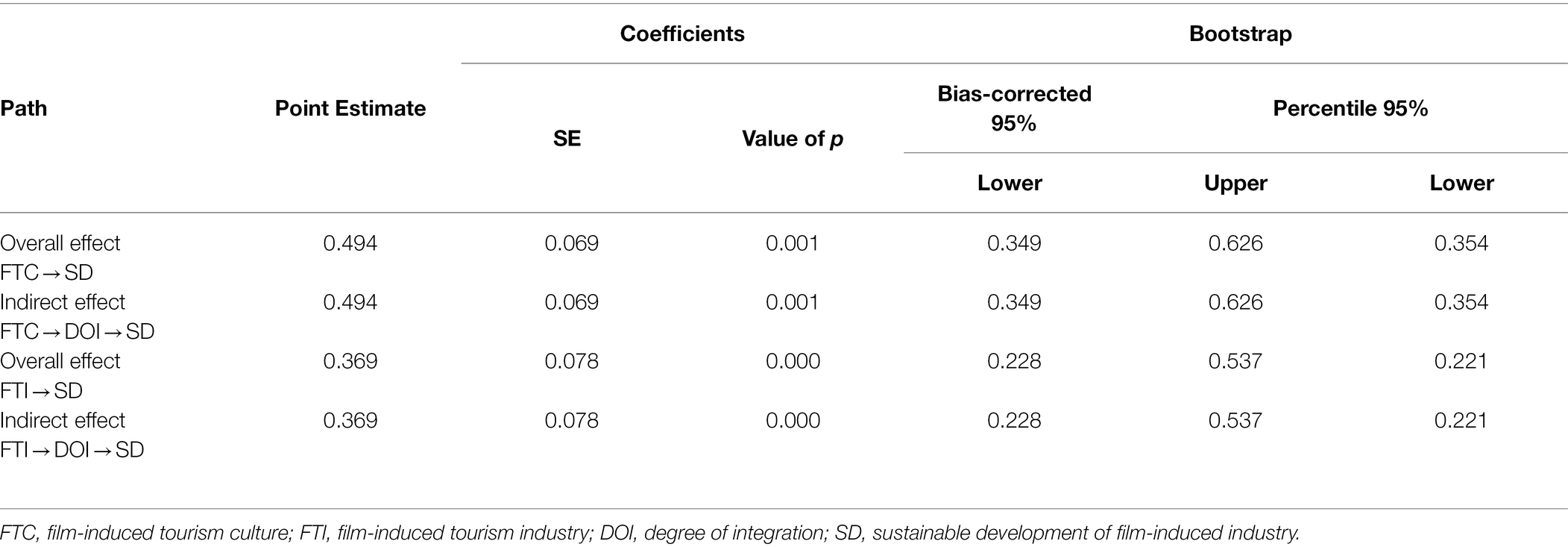
Table 7 . Empirical testing of mediating effects.
Given previous scholars’ studies on film-induced tourism ( Ringle, 2018 ; Marafa et al., 2020 ), we assume that cultural tourism will significantly affect the dynamic mechanism of sustainable development. More specifically, we believe that the organic integration of film-induced culture and tourism industry will have a significant impact on economic, social, and ecological sustainable development, which are the three dimensions of sustainable development. The results generally support our hypothesis that we view culture and tourism as a systematic whole rather than separate them and that culture and tourism integration is not simply “culture + tourism” or “tourism + culture.” We also confirm that the degree of integration of film-induced culture and tourism industry plays an important mediate role in the sustainable development of film-induced tourism. Although culture and tourism seem to be combined with each other in contemporary society, they have not developed the sustainable development dynamics of products and services innovation, nor developed a systematic operation mechanism. Consequently, the integration of culture and tourism is not to mechanically copy the two independent elements, but the key lies in the functional replacement and format innovation, complementary advantages, and the optimal combination of industrial elements.
Managerial Implications
As culture and tourism are two huge and complex systems, both have relatively mature management operation mechanism, working path, industrial rules, and industry norms, while they are currently characterized by high growth and rapid development ( Richards, 2018 ; McKercher, 2020 ). Therefore, in constructing the path of the integration of culture and tourism to promote sustainable development, the resource characteristics, functional differences, and technological advantages of film-induced culture and tourism industry should be fully considered in theory, and their similarity and relevance should be taken into account. In practice, we should not only make full use of the location conditions, resource endowments, and social and economic systems of film-induced culture and tourism destinations, but constantly identify the intersection points of products, industries, and enterprises according to the changes in market demand, and construct diversified industrial integration modes according to local conditions to determine develop directions in the integration of resources, technology, market and products, and administrative management.
From the perspective of tourism industry, support the development of organization forms that meet the needs of film-induced tourism development. The integration of industry should finally be reflected in the integration of organizations. Although the fundamental dynamics for the development of film-induced tourism is the development of market demand ( Connell, 2005 ), it needs enterprises to be discovered and satisfied to find business opportunities. We suggest relevant departments relax film-induced tourism business licensing, strengthen information services, support enterprises to explore new business areas, support various cooperation, and even merger and acquisitions. From the perspective of film-induced culture, enrich the cultural connotation of film-induced tourism. Film-induced tourism should not be equated with general implanted advertising or simply build film-induced bases, but should dig deeply into the cultural connotation of film-induced tourism, closely focus on the core theme of film/television works, and deeply develop “post-film products” related to tourism derivative industry, and then systematically integrate them to form a cross-industry and compound film-induced tourism industry chain ( Young and Young, 2008 ; Fan and Yu, 2021 ). In order to promote sustainable development, we further suppose that we should strengthen the research on film-induced tourism and explore the development mode and regulations of film-induced tourism.
Limitations and Future Directions
This study provides some enlightenments on the theoretical exploration and practical management of film-induced tourism. Inevitably, there are several limitations, which can be addressed in future studies. First, the verification of the hypotheses is through the empirical analysis of collected questionnaires, lacking the support of actual cases. This can be improved by case analysis in follow-up studies. Second, the degree of integration between culture and industry is measured and defined by their characteristics in this study. However, the integration may also be affected by their underlying relationship. Their spatial production characteristics are also valuable for further investigation. In summary, in this research, the dynamic mechanism for sustainable development of film-induced tourism has been investigated, and conclusions have been drawn. This topic, however, still requires in-depth follow-up investigations from the research community.
Data Availability Statement
The original contributions presented in the study are included in the article/supplementary material, further inquiries can be directed to the corresponding author.
Ethics Statement
The studies involving human participants were reviewed and approved by School of Economics and Management, East China Jiaotong University, Nanchang, China. The patients/participants provided their written informed consent to participate in this study. Written informed consent was obtained from the individual(s) for the publication of any potentially identifiable images or data included in this article.
Author Contributions
KY contributed to the empirical work, the analysis of the results, and the writing of the first draft. JinZ and JiaZ supported the total work of the KY. YZ and CX contributed to overall quality and supervision the part of literature organization and empirical work. RT contributed to developing research hypotheses and revised the overall manuscript. All authors discussed the results and commented on the manuscript. All authors contributed to the article and approved the submitted version.
This project was supported by the General Project of the National Social Science Fund of China: Tracking Research on the Development of Western Urban Politics (20BZZ055), General project of Humanities and Social Sciences General Research Program of the Ministry of Education: Research on the Generation Mechanism and Resolution Path of “Fragmentation Phenomenon” of Urban Social Governance (19YJA810002), Social Science Planning General Project in Jiangxi Province (No. 21XW06), Jiangxi Province Culture and Art Science Planning General Project (No. YG2021087), and Jiangxi Province Colleges Humanities and Social Science Project (No. GL20214).
Conflict of Interest
The authors declare that the research was conducted in the absence of any commercial or financial relationships that could be construed as a potential conflict of interest.
Publisher’s Note
All claims expressed in this article are solely those of the authors and do not necessarily represent those of their affiliated organizations, or those of the publisher, the editors and the reviewers. Any product that may be evaluated in this article, or claim that may be made by its manufacturer, is not guaranteed or endorsed by the publisher.
Adedoyin, F. F., Nathaniel, S., and Adeleye, N. (2021). An investigation into the anthropogenic nexus among consumption of energy, tourism, and economic growth: do economic policy uncertainties matter? Environ. Sci. Pollut. Res. 28, 2835–2847. doi: 10.1007/s11356-020-10638-x
PubMed Abstract | CrossRef Full Text | Google Scholar
Atilgan, E., Akinci, S., and Aksoy, S. (2003). Mapping service quality in the tourism industry. Manag. Serv. Qual. 13, 412–422. doi: 10.1108/09604520310495877
CrossRef Full Text | Google Scholar
Böhringer, C., and Jochem, P. E. (2007). Measuring the immeasurable—A survey of sustainability indices. Ecol. Econ. 63, 1–8. doi: 10.1016/j.ecolecon.2007.03.008
Cai, W. G., and Zhou, X. L. (2014). On the drivers of eco-innovation: empirical evidence from China. J. Clean. Prod. 79, 239–248. doi: 10.1016/j.jclepro.2014.05.035
Chen, C. Y. (2018). Influence of celebrity involvement on place attachment: Role of destination image in film tourism. Asia Pac. J. Tour. Res. 23, 1–14. doi: 10.1080/10941665.2017.1394888
Choi, S., and Ng, A. (2011). Environmental and economic dimensions of sustainability and price effects on consumer responses. J. Bus. Ethics 104, 269–282. doi: 10.1007/s10551-011-0908-8
Choi, H. S. C., and Sirakaya, E. (2005). Measuring residents’ attitude toward sustainable tourism: development of sustainable tourism attitude scale. J. Travel Res. 43, 380–394. doi: 10.1177/0047287505274651
Clark, G., and Chabrel, M. (2007). Measuring integrated rural tourism. Tour. Geograp. 9, 371–386. doi: 10.1080/14616680701647550
Connell, J. (2005). Toddlers, tourism and Tobermory: destination marketing issues and television-induced tourism. Tour. Manag. 26, 763–776. doi: 10.1016/j.tourman.2004.04.010
Delai, I., and Takahashi, S. (2011). Sustainability measurement system: a reference model proposal. Soc. Res. J. 7, 438–471. doi: 10.1108/17471111111154563
Diep, L., Martins, F. P., Campos, L. C., Hofmann, P., Tomei, J., Lakhanpaul, M., et al. (2021). Linkages between sanitation and the sustainable development goals: A case study of Brazil. Sustain. Dev. 29, 339–352. doi: 10.1002/sd.2149
Du, Y., Li, J., Pan, B., and Zhang, Y. (2020). Lost in Thailand: A case study on the impact of a film on tourist behavior. J. Vacat. Mark. 26, 365–377. doi: 10.1177/1356766719886902
Fan, Z., and Yu, X. (2021). The regional rootedness of China’s film industry: cluster development and attempts at cross-location integration. J. Chin. Film Stu. 1, 463–486. doi: 10.1515/jcfs-2021-0027
Gnoth, J., and Zins, A. H. (2013). Developing a tourism cultural contact scale. J. Bus. Res. 66, 738–744. doi: 10.1016/j.jbusres.2011.09.012
Gong, T., and Tung, V. W. S. (2017). The impact of tourism mini-movies on destination image: The influence of travel motivation and advertising disclosure. J. Travel Tour. Market. 34, 416–428. doi: 10.1080/10548408.2016.1182458
Hacking, T., and Guthrie, P. (2008). A framework for clarifying the meaning of triple bottom-line, integrated, and sustainability assessment. Environ. Impact Assess. Rev. 28, 73–89. doi: 10.1016/j.eiar.2007.03.002
Halme, M., and Korpela, M. (2014). Responsible innovation toward sustainable development in small and medium-sized enterprises: A resource perspective. Bus. Strateg. Environ. 23, 547–566. doi: 10.1002/bse.1801
He, K., Wu, H., Wu, J., Lu, Q., and Meng, J. (2021). The research of Libo County integrated development of cultural and tourism in the new era. Tour. Manage. Technol. Eco. 4, 1–8.
Google Scholar
Hojnik, J., and Ruzzier, M. (2016). What drives eco-innovation? A review of an emerging literature. Environ. Innov. Soc. Trans. 19, 31–41. doi: 10.1016/j.eist.2015.09.006
Hoogendoorn, B., Guerra, D., and Van der Zwan, P. (2015). What drives environmental practices of SMEs? Small Bus. Econ. 44, 759–781. doi: 10.1007/s11187-014-9618-9
Horbach, J., Oltra, V., and Belin, J. (2013). Determinants and specificities of eco-innovations compared to other innovations—an econometric analysis for the French and German industry based on the community innovation survey. Ind. Innov. 20, 523–543. doi: 10.1080/13662716.2013.833375
Huang, C. E., and Liu, C. H. (2018). The creative experience and its impact on brand image and travel benefits: The moderating role of culture learning. Tour. Manag. Perspect. 28, 144–155. doi: 10.1016/j.tmp.2018.08.009
Jabareen, Y. (2008). A new conceptual framework for sustainable development. Environ. Dev. Sustain 10, 179–192. doi: 10.1007/s10668-006-9058-z
Jakhar, S. K. (2017). Stakeholder engagement and environmental practice adoption: The mediating role of process management practices. Sustain. Dev. 25, 92–110. doi: 10.1002/sd.1644
Janssen, S., Kuipers, G., and Verboord, M. (2008). Cultural globalization and arts journalism: The international orientation of arts and culture coverage in Dutch, French, German, and US newspapers, 1955 to 2005. Am. Sociol. Rev. 73, 719–740. doi: 10.1177/000312240807300502
Jørgensen, M. T., and McKercher, B. (2019). Sustainability and integration–the principal challenges to tourism and tourism research. J. Travel Tour. Market. 36, 905–916. doi: 10.1080/10548408.2019.1657054
Jovicic, D. (2016). Cultural tourism in the context of relations between mass and alternative tourism. Curr. Issue Tour. 19, 605–612. doi: 10.1080/13683500.2014.932759
Kim, S., and Kim, S. (2018). Perceived values of TV drama, audience involvement, and behavioral intention in film tourism. J. Travel Tour. Market. 35, 259–272. doi: 10.1080/10548408.2016.1245172
Kim, S., Kim, S., and King, B. (2019). Nostalgia film tourism and its potential for destination development. J. Travel Tour. Market. 36, 236–252. doi: 10.1080/10548408.2018.1527272
Kristjánsdóttir, K. R., Ólafsdóttir, R., and Ragnarsdóttir, K. V. (2018). Reviewing integrated sustainability indicators for tourism. J. Sustain. Tour. 26, 583–599. doi: 10.1080/09669582.2017.1364741
Li, F., Katsumata, S., Lee, C. H., Ye, Q., Dahana, W. D., Tu, R., et al. (2020). Autoencoder-enabled potential buyer identification and purchase intention model of vacation homes. IEEE Access 8, 212383–212395. doi: 10.1109/ACCESS.2020.3037920
Li, X., Wirawan, D., Ye, Q., Peng, L., and Zhou, J. (2021). How does shopping duration evolve and influence buying behavior? The role of marketing and shopping environment. J. Retail. Consum. Serv. 62:102607. doi: 10.1016/j.jretconser.2021.102607
Liu, A., Fan, D. X., and Qiu, R. T. (2021a). Does culture affect tourism demand? A global perspective. J. Hosp. Tour. Res. 45, 192–214. doi: 10.1177/1096348020934849
Liu, B., Wang, Y., Katsumata, S., Li, Y., Gao, W., and Li, X. (2021b). National Culture and culinary exploration: Japan evidence of Heterogenous moderating roles of social facilitation. Front. Psychol. 12:784005. doi: 10.3389/fpsyg.2021.784005
Loulanski, T., and Loulanski, V. (2011). The sustainable integration of cultural heritage and tourism: A meta-study. J. Sustain. Tour. 19, 837–862. doi: 10.1080/09669582.2011.553286
Mamede, P., and Gomes, C. F. (2014). Corporate sustainability measurement in service organizations: A case study from Portugal. Environ. Qual. Manag. 23, 49–73. doi: 10.1002/tqem.21370
Marafa, L. M., Chan, C. S., and Li, K. (2020). Market potential and obstacles for film-induced tourism development in Yunnan Province in China. J. China Tour. Res. 18, 1–23. doi: 10.1080/19388160.2020.1819498
Marques, J., and Pinho, M. (2021). Collaborative research to enhance a business tourism destination: A case study from Porto. J. Policy Res. Tour. Leisure Events 13, 172–187. doi: 10.1080/19407963.2020.1756307
McKercher, B. (2002). Towards a classification of cultural tourists. Int. J. Tour. Res. 4, 29–38. doi: 10.1002/jtr.346
McKercher, B. (2020). Cultural tourism market: a perspective paper. Tour. Rev. 75, 126–129. doi: 10.1108/TR-03-2019-0096
Michael, N., Balasubramanian, S., Michael, I., and Fotiadis, S. (2020). Underlying motivating factors for movie-induced tourism among Emiratis and Indian expatriates in the United Arab Emirates. Tour. Hosp. Res. 20, 435–449. doi: 10.1177/1467358420914355
Misra, J. (2000). Integrating" the real world" into introduction to sociology: making sociological concepts real. Teach. Sociol. 28, 346–363. doi: 10.2307/1318584
Pérez García, Á., Sacaluga Rodríguez, I., and Moreno Melgarejo, A. (2021). The development of the competency of “cultural awareness and expressions” using movie-induced tourism as a didactic resource. Educ. Sci. 11:315. doi: 10.3390/educsci11070315
Richards, G. (2018). Cultural tourism: A review of recent research and trends. J. Hosp. Tour. Manag. 36, 12–21. doi: 10.1016/j.jhtm.2018.03.005
Riley, R., Baker, D., and Van Doren, C. S. (1998). Movie induced tourism. Ann. Tour. Res. 25, 919–935. doi: 10.1016/S0160-7383(98)00045-0
Ringle, C. (2018). In print and On screen: film columns, criticism, and culture in early Hollywood-Richard Abel. Enterp. Soc. 19, 216–225. doi: 10.1017/eso.2017.51
Schaltegger, S., Hansen, E. G., and Lüdeke-Freund, F. (2016). Business models for sustainability: origins, present research, and future avenues. Organ. Environ. 29, 3–10. doi: 10.1177/1086026615599806
Senbeto, D. L., and Hon, A. H. (2021). Shaping organizational culture in response to tourism seasonality: A qualitative approach. J. Vacat. Mark. 27, 466–478. doi: 10.1177/13567667211006759
Silberberg, T. (1995). Cultural tourism and business opportunities for museums and heritage sites. Tour. Manag. 16, 361–365. doi: 10.1016/0261-5177(95)00039-Q
Singh, R. K., Murty, H. R., Gupta, S. K., and Dikshit, A. K. (2009). An overview of sustainability assessment methodologies. Ecol. Indic. 9, 189–212. doi: 10.1016/j.ecolind.2008.05.011
Steffen, W., Richardson, K., Rockström, J., Cornell, S. E., Fetzer, I., Bennett, E. M., et al. (2015). Planetary boundaries: guiding human development on a changing planet. Science 347:1259855. doi: 10.1126/science.1259855
Stuckey, A. (2021). Special effects and spectacle: integration of CGI in contemporary Chinese film. J. Chin. Film Stu. 1, 49–64. doi: 10.1515/jcfs-2021-0005
Sun, G., Han, X., Wang, H., Li, J., and Wang, W. (2021). The influence of face loss on impulse buying: An experimental study. Front. Psychol. 12:700664. doi: 10.3389/fpsyg.2021.700664
Sun, G., Wang, W., Cheng, Z., Li, J., and Chen, J. (2017). The intermediate linkage between materialism and luxury consumption: evidence from the emerging market of China. Soc. Indic. Res. 132, 475–487. doi: 10.1007/s11205-016-1273-x
Suni, J., and Komppula, R. (2012). SF-Film village as a movie tourism destination—a case study of movie tourist push motivations. J. Travel Tour. Market. 29, 460–471. doi: 10.1080/10548408.2012.691397
Svensson, G., and Wagner, B. (2015). Implementing and managing economic, social and environmental efforts of business sustainability: Propositions for measurement and structural models. Manage. Environ. Q. Int. J. 26, 195–213. doi: 10.1108/MEQ-09-2013-0099
Syafrini, D., Fadhil Nurdin, M., Sugandi, Y. S., and Miko, A. (2020). The impact of multiethnic cultural tourism in an Indonesian former mining city. Tour. Recreat. Res. 45, 511–525. doi: 10.1080/02508281.2020.1757208
Teng, H. Y. (2021). Can film tourism experience enhance tourist behavioural intentions? The role of tourist engagement. Curr. Issue Tour. 24, 2588–2601. doi: 10.1080/13683500.2020.1852196
Teng, H. Y., and Chen, C. Y. (2020). Enhancing celebrity fan-destination relationship in film-induced tourism: The effect of authenticity. Tour. Manag. Perspect. 33:100605. doi: 10.1016/j.tmp.2019.100605
Tien, N. H., Viet, P. Q., Duc, N. M., and Tam, V. T. (2021). Sustainability of tourism development in Vietnam's coastal provinces. World Rev. Ent. Manage. Sustainable Dev. 17, 579–598. doi: 10.1504/WREMSD.2021.117443
Wagner, B. (2015). Implementing and managing economic, social and environmental efforts of business sustainability. Manage. Environ. Q. Int. J. 26, 195–213. doi: 10.1108/MEQ-09-2013-0099
Waheed, A., Zhang, Q., Rashid, Y., Tahir, M. S., and Zafar, M. W. (2020). Impact of green manufacturing on consumer ecological behavior: Stakeholder engagement through green production and innovation. Sustain. Dev. 28, 1395–1403. doi: 10.1002/sd.2093
Wang, W., Chen, N., Li, J., and Sun, G. (2020a). SNS use leads to luxury brand consumption: Evidence from China. J. Consum. Mark. 38, 101–112. doi: 10.1108/JCM-09-2019-3398
Wang, W., Ma, T., Li, J., and Zhang, M. (2020b). The pauper wears prada? How debt stress promotes luxury consumption. J. Retail. Consum. Serv. 56:102144. doi: 10.1016/j.jretconser.2020.102144
Wang, C., and Yi, K. (2020). Impact of spatial scale of ocean views architecture on tourist experience and empathy mediation based on “SEM-ANP” combined analysis. J. Coast. Res. 103, 1125–1129. doi: 10.2112/SI103-235.1
Wen, H., Josiam, B. M., Spears, D. L., and Yang, Y. (2018). Influence of movies and television on Chinese tourists perception toward international tourism destinations. Tour. Manag. Perspect. 28, 211–219. doi: 10.1016/j.tmp.2018.09.006
Williams, S., and Schaefer, A. (2013). Small and medium-sized enterprises and sustainability: Managers' values and engagement with environmental and climate change issues. Bus. Strateg. Environ. 22, 173–186. doi: 10.1002/bse.1740
Wu, X., and Lai, I. K. W. (2021). The acceptance of augmented reality tour app for promoting film-induced tourism: the effect of celebrity involvement and personal innovativeness. J. Hosp. Tour. Technol. 12, 454–470. doi: 10.1108/JHTT-03-2020-0054
Xin, X. R., and Mossig, I. (2017). Co-evolution of institutions, culture and industrial organization in the film industry: The case of Shanghai in China. Eur. Plan. Stud. 25, 923–940. doi: 10.1080/09654313.2017.1300638
Yen, C. H., and Croy, W. G. (2016). Film tourism: celebrity involvement, celebrity worship and destination image. Curr. Issue Tour. 19, 1027–1044. doi: 10.1080/13683500.2013.816270
Yi, K., Li, Y., Peng, H., Wang, X., and Tu, R. (2021a). Empathic psychology: A code of risk prevention and control for behavior guidance in the multicultural context. Front. Psychol. 12:781710. doi: 10.3389/fpsyg.2021.781710
Yi, K., Wang, Q., Xu, J., and Liu, B. (2021b). Attribution model of travel intention to internet celebrity spots: A systematic exploration based on psychological perspective. Front. Psychol. 12:797482. doi: 10.3389/fpsyg.2021.797482
Yi, K., Zhang, D., Cheng, H., Mao, X., and Su, Q. (2020). SEM and K-means analysis of the perceived value factors and clustering features of marine film-induced tourists: A case study of tourists to Taipei. J. Coast. Res. 103, 1120–1124. doi: 10.2112/SI103-234.1
Young, A. F., and Young, R. (2008). Measuring the effects of film and television on tourism to screen locations: A theoretical and empirical perspective. J. Travel Touri. Market. 24, 195–212. doi: 10.1080/10548400802092742
Yu, C. P., Chancellor, H. C., and Cole, S. T. (2011). Measuring residents’ attitudes toward sustainable tourism: A reexamination of the sustainable tourism attitude scale. J. Travel Res. 50, 57–63. doi: 10.1177/0047287509353189
Zhang, L., Yi, K., and Zhang, D. (2020). The classification of environmental crisis in the perspective of risk communication: A case study of coastal risk in mainland China. J. Coast. Res. 104, 88–93. doi: 10.2112/JCR-SI104-016.1
Zhou, Z., Zheng, F., Lin, J., and Zhou, N. (2021). The interplay among green brand knowledge, expected eudaimonic well-being and environmental consciousness on green brand purchase intention. Corp. Soc. Responsib. Environ. Manag. 28, 630–639. doi: 10.1002/csr.2075
Keywords: film-induced tourism, tourism destination, sustainable development, dynamic mechanism, culture and industry integration
Citation: Yi K, Zhu J, Zeng Y, Xie C, Tu R and Zhu J (2022) Sustainable Development for Film-Induced Tourism: From the Perspective of Value Perception. Front. Psychol . 13:875084. doi: 10.3389/fpsyg.2022.875084
Received: 13 February 2022; Accepted: 13 May 2022; Published: 03 June 2022.
Reviewed by:
Copyright © 2022 Yi, Zhu, Zeng, Xie, Tu and Zhu. This is an open-access article distributed under the terms of the Creative Commons Attribution License (CC BY) . The use, distribution or reproduction in other forums is permitted, provided the original author(s) and the copyright owner(s) are credited and that the original publication in this journal is cited, in accordance with accepted academic practice. No use, distribution or reproduction is permitted which does not comply with these terms.
*Correspondence: Yanqin Zeng, [email protected]
Disclaimer: All claims expressed in this article are solely those of the authors and do not necessarily represent those of their affiliated organizations, or those of the publisher, the editors and the reviewers. Any product that may be evaluated in this article or claim that may be made by its manufacturer is not guaranteed or endorsed by the publisher.
This website requires Javascript for some parts to function properly. Your experience may vary.
How can the film‐induced tourism phenomenon be sustainably managed?
O'Connor, N. (2011). How can the film‐induced tourism phenomenon be sustainably managed?. Worldwide Hospitality and Tourism Themes, 3(2), 87-90.
Location, location, location: Film corporations' social responsibilities
Beeton, S. (2008). Location, location, location: Film corporations' social responsibilities. Journal of Travel & Tourism Marketing, 24(2-3), 107-114.
Partnerships and social responsibility: leveraging tourism and international film business
Beeton, S. (2008). Partnerships and social responsibility: leveraging tourism and international film business. In International business and tourism (pp. 270-286). Routledge.
Advancing social sustainability in film tourism
Buchmann, A. (2012). Advancing social sustainability in film tourism. Tourism review international, 16(2), 89-100.
‘What’s the story in Balamory?’: The impacts of a children’s TV programme on small tourism enterprises on the Isle of Mull, Scotland
Connell, J. (2005). ‘What’s the story in Balamory?’: The impacts of a children’s TV programme on small tourism enterprises on the Isle of Mull, Scotland. Journal of Sustainable Tourism, 13(3), 228-255.
Film Tourism: Sustained Economic Contributions to Destinations
Croy, W. Glen. “Film Tourism: Sustained Economic Contributions to Destinations.” Worldwide Hospitality and Tourism Themes, vol. 3, no. 2, Apr. 2011, pp. 159–64.
Film Tourism Planning and Development—Questioning the Role of Stakeholders and Sustainability
Heitmann, Sine. “Film Tourism Planning and Development—Questioning the Role of Stakeholders and Sustainability.” Tourism and Hospitality Planning & Development, vol. 7, no. 1, Mar. 2010, pp. 31–46. Taylor & Francis Online,
Sustainable development for film-induced tourism: from the perspective of value perception
Kui, Y., Jing, Z., Yanqin, Z., Changqing, X., Rungting, T., & Jianfei, Z. (2022). Sustainable development for film-induced tourism: from the perspective of value perception, 13.
Sustainable Management of Popular Culture Tourism Destinations: A Critical Evaluation of the Twilight Saga Servicescapes
Lundberg, Christine, and Kristina N. Lindström. “Sustainable Management of Popular Culture Tourism Destinations: A Critical Evaluation of the Twilight Saga Servicescapes.” Sustainability, vol. 12, no. 12, 5177, June 2020,
Creating a sustainable brand for Northern Ireland through film-induced tourism
O'Connor, N., & Bolan, P. (2008). Creating a sustainable brand for Northern Ireland through film-induced tourism .Tourism Culture & Communication, 8(3), 147-158.
Film tourism and ecotourism: mutually exclusive or compatible?
Sakellari, M. (2014). Film tourism and ecotourism: mutually exclusive or compatible?. International journal of culture, tourism and hospitality research.
Is Tourism Going Green? A Literature Review on Green Innovation for Sustainable Tourism
Satta, Giovanni, et al. “Is Tourism Going Green? A Literature Review on Green Innovation for Sustainable Tourism.” Tourism Analysis, vol. 24, no. 3, Cognizant, LLC, July 2019, pp. 265–80.
KPMG Personalisation

Transforming location into vacation - A report on film tourism
The report emphasises the need for India to leverage its abundant cinematic heritage to position itself as a leading film tourism destination.
- Share Share close
- Download Transforming location into vacation - A report on film tourism pdf Opens in a new window
- 1000 Save this article to my library
- Go to bottom of page
- Home ›
- Insights ›
The report emphasises the need for India to leverage its abundant cinematic heritage and diverse landscapes to position itself as a leading film-tourism destination, thereby contributing to its economic growth and cultural preservation. It highlights the current state of the film tourism industry and explores successful global and Indian case studies of film tourism, demonstrating the economic, cultural, and promotional benefits while addressing challenges such as over-commercialisation and ecological damage. It concludes with recommendations for India to unlock its film tourism potential and establish itself as a preferred destination for film tourism.

Key Contact

Best Practices in Hospitality and Tourism Marketing and Management pp 181–199 Cite as
Film Tourism and Its Impact on Residents Quality of Life: A Multi Logit Analysis
- Subhash Kizhakanveatil Bhaskaran Pillai 3 ,
- Kaustubh Kamat 4 ,
- Miriam Scaglione 5 ,
- Carmelita D’Mello 6 &
- Klaus Weiermair 7 , 8
- First Online: 31 July 2018
1094 Accesses
2 Citations
Part of the book series: Applying Quality of Life Research ((BEPR))
Past research has confirmed film tourism emerging as a major growth sector for research in tourism and a driver of tourism development for many destinations. To date, there has been relatively substantial literature on the subject, yet this paper tries to shed some light on the quality of life perception with respect to the International Film Festival of India (IFFI). Earlier research results have shown different impacts of film tourism on the quality of life of the local community, and the perceptions and attitudes of residents towards tourism, but no research has shown neither how nor how much these perceptions and attitudes change according to a change in the demographic profile of the local community. The empirical findings show that: age, income, education and marital status have a significant impact on residents’ attitude towards film tourism. Factor analysis resulted in 4 latent factors which drive residents’ perception about quality of life, viz., Community Pride, Personal Benefits, Negative Environmental effect and Negative Social effect. The results have shown that a variation in the demographic profile of the resident community determines a variation in the attitudes towards tourism impacts. In a time of mass movement of people, man power and immigration, changes in the demographic profile of residents are very likely and this research shows that it should be taken into consideration when managing tourism destinations and planning new tourism policies.
This is a preview of subscription content, log in via an institution .
Buying options
- Available as PDF
- Read on any device
- Instant download
- Own it forever
- Available as EPUB and PDF
- Compact, lightweight edition
- Dispatched in 3 to 5 business days
- Free shipping worldwide - see info
- Durable hardcover edition
Tax calculation will be finalised at checkout
Purchases are for personal use only
Andereck, K. L., & Vogt, C. A. (2000). The relationship between residents’ attitudes toward tourism and tourism development options. Journal of Travel Research, 39 (1), 27–36.
Article Google Scholar
Ap, J. (1992). Residents’ perceptions on tourism impacts. Annals of Tourism Research, 19 (4), 665–690.
Ap, J., & Crompton, J. L. (1993). Residents’ strategies in responding to tourism impacts. Journal of Travel Research, 17 (4), 610–616.
Google Scholar
Beeton, S. (2001). Smiling for the camera: The influence of film audiences on a budget tourism destination. Tourism, Culture and Communication, 3 , 15–25.
Beeton, S. (2004a). The more things change. A legacy of film-induced tourism. In W. Frost, W. G. Croy, & S. Beeton (Eds.), Proceedings of the international tourism and media conference (pp. 4–14). Melbourne: Australia, Tourism Research Unit, Monash University.
Beeton, S. (2004b). Rural tourism in Australia: Has the gaze altered? Tracking rural images though film and tourism promotion. International Journal of Tourism Research, 6 (3), 125–135.
Beeton, S. (2005). Film-induced tourism . Clevedon: Channel View Publications.
Book Google Scholar
Brayley, R., Var, T., & Sheldon, P. (1990). Perceived influence of tourism on social issues. Annals of Tourism Research, 17 (2), 284–289.
Busby, G., & Klug, J. (2001). Movie-induced tourism: The challenge of measurement and other issues. Journal of Vacation Marketing, 7 (4), 316–332.
Busby, G., Ergul, M., & Eng, J. (2013). Film tourism and the lead actor: An exploratory study of the influence on destination image and branding. Anatolia: An International Journal of Tourism and Hospitality Research, 24 , 395–404.
Connell, J. (2005a). Toddlers, tourism and Tobermory: Destination marketing issues and TV-induced tourism. Tourism Management, 26 , 763–776.
Connell, J. (2005b). What’s the story in Balamory? The impacts of a children’s TV programme on small tourism enterprises on the Isle of Mull, Scotland. Journal of Sustainable Tourism, 13 , 228–255.
Connell, J. (2012). Film tourism: Evolution, progress and prospects. Tourism Management, 33 (5), 1007–1029.
Couldry, N. (2005). On the actual street. In D. Crouch, R. Jackson, & F. Thompson (Eds.), The media and the tourist imagination. Converging cultures (pp. 60–75). London: Routledge.
Crompton, J. L., Lee, S., & Shuster, T. J. (2001). A guide for undertaking economic impact studies: The Springfest example. Journal of Travel Research, 40 (1), 79–87.
Croy, W. G. (2010). Planning for film tourism: Active destination image management. Tourism and Hospitality Planning & Development, 7 (1), 21–30.
Croy, W. G. (2011). Film tourism: Sustained economic contributions to destinations. Worldwide Hospitality and Tourism Themes, 3 (2), 159–164.
Croy, W. G., & Heitmann, S. (2011). Tourism and film. In P. Robinson, S. Heitmann, & P. Dieke (Eds.), Research themes in tourism (pp. 188–204). Wallingford: CABI.
Chapter Google Scholar
Croy, G., & Walker, R. D. (2003). Rural tourism and film e issues for strategic rural development. In D. Hall, L. Roberts, & M. Mitchell (Eds.), New directions in rural tourism (pp. 115–133). Aldershot: Ashgate.
Deprez, C. (2013). The film division of India, 1948–1964: The early days and the influence of the British documentary film tradition. Film History, 25 (3), 149–173.
DFF. (2015). International Film Festival of India. Directorate of Film Festivals. http://www.dff.nic.in/iffi.asp . Accessed 9 June 2015.
D’Mello, C., Chang, L., Kamat, K., Scaglione, M., Weiermair, K., & Subhash, K. B. (2015). An examination of factors influencing tourists attitude towards tourism in Goa. International Journal of Tourism and Hospitality Systems, 8 (2), 1–11.
D’Mello, C., Fernandes, S., Zimmermann, F. M., Subhash, K. B., & Ganef, J. P. (2016a). Multi-stakeholder perceptions about sustainable tourism in Goa: A structural equation modeling. International Journal of Tourism and Travel, 9 (1–2), 21–39.
D’Mello, C., Chang, L., Subhash, K. B., Kamat, K., Zimmermann, F. M., & Weiermair, K. (2016b). Comparison of multi-stakeholder perception of tourism sustainability in Goa. International Journal of Tourism and Hospitality Systems, 11 (2), 1–13.
Getz, D., & Page, S. J. (2016). Progress and prospects for event tourism research. Tourism Management, 52 , 593–631.
Giacopassi, D., & Stitt, B. G. (1994). Assessing the impact of casino gambling on crime in Mississippi. American Journal of Criminal Justice, 18 (1), 117–131.
Heitmann, S. (2010). Film tourism planning and development - questioning the role of stakeholders and sustainability. Tourism and Hospitality Planning & Development, 7 (1), 31–46.
Hudson, S., & Ritchie, J. R. B. (2006a). Promoting destinations via film tourism: An empirical identification of supporting marketing initiatives. Journal of Travel Research, 44 , 387–396.
Hudson, S., & Ritchie, J. R. B. (2006b). Film tourism and destination marketing: The case of Captain Corelli’s Mandolin. Journal of Vacation Marketing, 12 (3), 256–268.
Hudson, S., & Tung, V. W. T. (2010). “Lights, camera, action...!” Marketing film locations to Hollywood. Marketing Intelligence and Planning, 28 (2), 188–205.
Hudson, S., Wang, Y., & Gil, S. M. (2010). The influence of a film on destination image and the desire to travel: A cross-cultural comparison. International Journal of Tourism Research, 13 , 177–190.
IFFI. (2015). International Film Festival of India. http://www.iffi.nic.in/aboutus.asp . Accessed 9 June 2015.
Jurowski, C. (1994). The interplay of elements affecting host communityresident attitudes toward tourism: A path analytic approach . Unpublished Ph.D.dissertation, Department of Hospitality and Tourism Management, VirginiaPolytechnic Institute and State University.
Jurowski, C., Uysal, M., & Williams, D. R. (1997). A theoretical analysis of host community resident reactions to tourism. Journal of Travel Research, 34 (2), 3–11.
Kaiser, H. F. (1974). An index of factorial simplicity. Psychometrika, 39 , 31–36.
Kamat, K., Chen, R. F., D’Mello, C., Scaglione, M., Weiermair, K., & Subhash, K. B. (2016). The social, economic, and environmental impacts of Casino tourism on the residents of Goa. Latin American Tourismology Review [Revista Latino-Americana De Tourismologia], 2 (1), 44–54.
Kim, K., Uysal, M., & Sirgy, M. J. (2013). How does tourism in a community impact the quality of life of community residents? Tourism Management, 36 , 527–540.
Kim, S. (sean), Kim, S. (San), & Oh, M. (2017). Film tourism town and its local community. International Journal of Hospitality & Tourism Administration . https://doi.org/10.1080/15256480.2016.1276005 . Accessed 9 June 2017.
Knowindia. (2015). Cinema in India: Film Division . http://knowindia.gov.in/knowindia/cinema.php . Accessed 9 June 2015.
Lankford, S. V., & Howard, D. (1994). Revising TIAS. Annals of Tourism Research, 21 (4), 829–831.
Lee, C. K., Kang, S. K., Long, P., & Reisinger, Y. (2010). Residents’ perceptions of casino impacts: A comparative study. Tourism Management, 31 (2), 189–201.
Li, S., Li, H., Song, H., Lundberg, C., & Shen, S. (2017). The economic impact of on-screen tourism: The case of The Lord of the Rings and the Hobbit. Tourism Management, 60 , 177–187.
Lin, Y. S., & Huang, J. Y. (2008). Analyzing the use of TV mini-series for Korea tourism marketing. Journal of Travel & Tourism Marketing, 24 (2–3), 223–227.
Lin, Y. S., Lin, P. L., & Huang, H. L. (2007). Study on correlation among tourists’ travel behavior, service quality, satisfaction and loyalty – Using Jian Hu Shan Theme Park as an example. Journal of Sport, Leisure and Hospitality Research, 2 (2), 67–83.
Mordue, T. (2001). Performing and directing resident/tourist cultures in heartbeat country. Tourist Studies, 1 , 233–252.
Mordue, T. (2009). Television, tourism and rural life. Journal of Travel Research, 47 (3), 332–345.
Mueller, C. (2006). Film festival tourism . http://www.filmfestivals.com/cgi-bin/shownews.pl . Accessed 15 Sept 2008.
Murphy, P. E., & Carmichael, B. A. (1991). Assessing the tourism benefits of an open access sports tournament: The 1989 B.C. winter games. Journal of Travel Research, 29 , 32–36.
O’Neill, K., Butts, S., & Busby, G. (2005). The corellification of Cephallonian tourism. Anatolia, 16 (2), 207–226.
Pizam, A., & Pokela, J. (1985). The perceived impacts of casino gambling on the community. Annals of Tourism Research, 12 (2), 147–165.
Riley, R., & van Doren, C. (1992). Movies as tourism promotion: A push factor in a pull location. Tourism Management, 13 , 267–274.
Riley, R., Baker, D., & van Doren, C. (1998). Movie-induced tourism. Annals of Tourism Research, 25 , 919–935.
Rojek, C. (1995). Decentring leisure. Rethinking leisure theory . London: Sage.
Sine, H. (2010). Film tourism planning and developments – Questioning the role of stakeholders and sustainability. Tourism and Hospitality Planning & Development, 7 (1), 31–46.
Stitt, B. G., Nicholas, M., & Giacopassi, D. (2003). Does the presence of casinos increase crime? An examination of casino and control communities. Crime & Dilinquency, 49 , 253–283.
Subhash, K. B., & Chen, R. (2012). Geography of transnational terrorism: An Indian perspective. In S. Sharma, D. Das, R. Jain, & P. S. Sangwan (Eds.), India emerging: Opportunities and challenges (pp. 106–124). New Delhi: Pragun Publication.
Tabachnick, B. G., & Fidell, L. S. (1989). Using multivariale statistics (2nd ed.). Cambridge: Harper & Row.
Tooke, N., & Baker, M. (1996). Seeing is believing: The effect of film on visitor numbers to screened locations. Tourism Management, 17 , 87–94.
Wiki. (2015a). History of Goa . https://en.wikipedia.org/wiki/History_of_Goa . Accessed 18 June 2015.
Wiki. (2015b). Timeline of Goan History . https://en.wikipedia.org/wiki/Timeline_of_Goan_history . Accessed 18 June 2015.
Zhang, X., Ryan, C., & Cave, J. (2016). Residents, their use of a tourist facility and contribution to tourist ambience: Narratives from a film tourism site in Beijing. Tourism Management, 52 , 416–429.
Download references
Acknowledgement
Authors acknowledge the constructive criticism received from two anonymous referees, which helped in bringing the paper in its present form. Authors also acknowledge the English proofreading and editing support by Simone Dimitriou, Assistant of Research, Institute of Tourism, University of Applied Sciences and Arts Western Switzerland, Valais.
Author information
Authors and affiliations.
Department of Commerce, Goa University, Goa, India
Subhash Kizhakanveatil Bhaskaran Pillai
Department of Business Administration, Goa Multi-Faculty College, Goa, India
Kaustubh Kamat
Institute of Tourism, University of Applied Sciences and Arts Western Switzerland, HES-SO Valais, Sierre, Switzerland
Miriam Scaglione
Department of Commerce, St. Xavier’s College of Arts, Science & Commerce, Goa, India
Carmelita D’Mello
Schulich School of Business, York University Toronto, York, Canada
Klaus Weiermair
Department of Tourism and Service Management, Institute of Strategic Management, Marketing and Tourism, University of Innsbruck, Innsbruck, Austria
You can also search for this author in PubMed Google Scholar
Corresponding author
Correspondence to Subhash Kizhakanveatil Bhaskaran Pillai .
Editor information
Editors and affiliations.
School of Business, Finance and Tourism, University of Extremadura, Cáceres, Spain
Ana María Campón-Cerro , José Manuel Hernández-Mogollón & José Antonio Folgado-Fernández , &
Rights and permissions
Reprints and permissions
Copyright information
© 2019 Springer International Publishing AG, part of Springer Nature
About this chapter
Cite this chapter.
Pillai, S.B., Kamat, K., Scaglione, M., D’Mello, C., Weiermair, K. (2019). Film Tourism and Its Impact on Residents Quality of Life: A Multi Logit Analysis. In: Campón-Cerro, A.M., Hernández-Mogollón, J.M., Folgado-Fernández, J.A. (eds) Best Practices in Hospitality and Tourism Marketing and Management. Applying Quality of Life Research. Springer, Cham. https://doi.org/10.1007/978-3-319-91692-7_9
Download citation
DOI : https://doi.org/10.1007/978-3-319-91692-7_9
Published : 31 July 2018
Publisher Name : Springer, Cham
Print ISBN : 978-3-319-91691-0
Online ISBN : 978-3-319-91692-7
eBook Packages : Social Sciences Social Sciences (R0)
Share this chapter
Anyone you share the following link with will be able to read this content:
Sorry, a shareable link is not currently available for this article.
Provided by the Springer Nature SharedIt content-sharing initiative
- Publish with us
Policies and ethics
- Find a journal
- Track your research
An official website of the United States government
The .gov means it’s official. Federal government websites often end in .gov or .mil. Before sharing sensitive information, make sure you’re on a federal government site.
The site is secure. The https:// ensures that you are connecting to the official website and that any information you provide is encrypted and transmitted securely.
- Publications
- Account settings
Preview improvements coming to the PMC website in October 2024. Learn More or Try it out now .
- Advanced Search
- Journal List
- Front Psychol
Sustainable Development for Film-Induced Tourism: From the Perspective of Value Perception
1 School of Business and Trade, Nanchang Institute of Science & Technology, Nanchang, China
2 Media Art Research Center, Jiangxi Institute of Fashion Technology, Nanchang, China
3 Guangdong University of Finance and Economics, Guangzhou, China
Yanqin Zeng
4 Department of Art Integration, Daejin University, Pocheon, South Korea
Changqing Xie
5 School of Business, Foshan University, Foshan, China
Rungting Tu
6 College of Management, Shenzhen University, Shenzhen, China
Jianfei Zhu
7 School of Economics and Management, East China Jiaotong University, Nanchang, China
Associated Data
The original contributions presented in the study are included in the article/supplementary material, further inquiries can be directed to the corresponding author.
The tourism economy has become a new driving force for economic growth, and film-induced tourism in particular has been widely proven to promote economic and cultural development. Few studies focus on analyzing the inherent characteristics of the economic and cultural effects of film-induced tourism, and the research on the dynamic mechanism of the sustainable development of film-induced tourism is relatively limited. Therefore, from the perspective of the integration of culture and industry, the research explores the dynamic mechanism of sustainable development between film-induced culture and film-induced industry through a questionnaire survey of 1,054 tourism management personnel, combined with quantitative empirical methods. The conclusion shows that the degree of integration of culture and tourism is an important mediating role that affects the dynamic mechanism of sustainable development of film-induced tourism, and the development of film-induced tourism depends on the integration of culture and industry. Constructing a diversified industrial integration model according to local conditions and determining the development path of resource, technology, market, product integration, and administrative management can become the general trend of the future development of film-induced tourism.
Introduction
As an emerging industry, cultural tourism can make up for the economic difficulties caused by the weak growth of the primary and secondary industries, and replace it as a new driving force for economic growth ( Liu et al., 2021b ). As recognized by both the academic community and industry, cultural tourism products greatly impact tourism destination development; souvenir, local cuisines, and films/television programs can promote tourism destinations ( Liu et al., 2021a , b ). Among them, film/television is the most influential form of art in today’s society. Film and television can help potential tourists to have some sensory and emotional cognitions through empathy and vicarious feeling to the tourist destinations mentioned in the films ( Kim and Kim, 2018 ; Pérez García et al., 2021 ), thereby generating tourism motivation and ultimately promoting tourism behaviors. Film and television, without exception, have integrated commerciality and artistry since birth, and form a unique form of culture ( Riley et al., 1998 ).
Hence, these significant economic effects have been widely investigated by researchers from different perspectives, such as promotion of local brands ( Liu et al., 2021a ), and changes in aesthetic information dissemination ( Kim et al., 2019 ). With in-depth studies, researchers have identified the profound connotation of the rapid development of film-induced tourism: the extension of the immersive tourism ( Marafa et al., 2020 ), the endowment of modern fashion labels for tourism destinations ( Teng and Chen, 2020 ), and multi-dimensional integrations of modern media technology and traditional entertainment industry.
Culture is the soul of tourism, and tourism is an important carrier of culture. Although the experience of film/television is different from tourism—the former is provided to people by means of image transmission, and the latter is realized by the way of people moving—but the essence is both cultural experience ( Syafrini et al., 2020 ; Senbeto and Hon, 2021 ). The connotation and the applied research of film-induced tourism reveal the complexity and diversity of the integrations of modern media and traditional entertainment.
The traditional glimmering style sightseeing tour is just a shallow taste, and often cannot make tourists get a deep enjoyment. Film-induced tourism is different, mature film-induced tourism products can bring tourists wholehearted relaxation and enjoyment, and make tourists’ self-worth better reflect. To clarify the inherent characteristics of film-induced tourism, the interactive observation of both the film and television subject and the tourism subject provides a feasible solution. Film/television programs are the expression and substantiveness of culture ( Yi et al., 2020 ). Tourism as an economic carrier is the pattern and standardization of the industry ( Yen and Croy, 2016 ). The development of film-induced tourism relies on the mutual integration of culture and industry.
With the evolution of the world, sustainable development is leading the way in every industry including tourism. The early understanding of sustainable development in the academic community refers to meeting the needs of the current generation without damaging the needs of future generations’ development ( Jabareen, 2008 ; Yi et al., 2021a ). Based on this concept, the United Nations has formulated 17 sustainable development goals, proposed new standards for the prosperity and development of the earth, and standardized the assessment methods and indicators for sustainable development ( Böhringer and Jochem, 2007 ; Hacking and Guthrie, 2008 ; Singh et al., 2009 ). Since then, the concept of sustainable development has been fully implemented and has gradually become a well-known concept from the perspectives of the environment, economy, and society ( Adedoyin et al., 2021 ; Diep et al., 2021 ; Zhou et al., 2021 ). Currently, these three dimensions are identified as the motivations and mechanisms of sustainable development ( Steffen et al., 2015 ; Svensson and Wagner, 2015 ). Specifically, challenges in sustainable development are vital issues for exploring social and economic development. Economic benefits are the main dynamics of continuous action ( Hoogendoorn et al., 2015 ), with social effects as the main motivation of practice ( Williams and Schaefer, 2013 ), and environmental effects as the basic assurances of all activities ( Halme and Korpela, 2014 ). Hence, sustainable development research help explore the path of the industry development. The dynamic mechanism of sustainable development builds the foundation for the long-term influence of the culture and provides the way for continuous development and expansion of industrial effects ( Waheed et al., 2020 ). At present, to the best of our knowledge, very few studies have investigated the dynamic mechanism of the sustainable development for film-induced tourism. The existing studies which include the sustainable development dynamic mechanism can be divided into three aspects:
(1) The macro sustainable development concept of film-induced tourism ( Wen et al., 2018 ); (2) The sustainable development concept in the exploration of film-induced tourism ( Gong and Tung, 2017 ; Teng, 2021 ); (3) The micro sustainable development concept of film-induced tourism ( Suni and Komppula, 2012 ). Afterward, most of the studies believe that the dynamic mechanism of sustainable development is affected by its resource development, innovation mode, or artistic attractions. However, these have not yet conducted a quantitative study of the endogenous interactions between culture and industry. Accordingly, we try to fill the research gap; we study the relationship between culture and industry in film-induced tourism through structural equation modeling to promote the sustainable development dynamics brought about the integration of culture and industry.
Literature Review
Film-induced culture and tourism industry.
Film-induced culture plays a vital role in the global advertisement system. It is an effective approach for the advertisement of regional values and soft power, and it is a good pathway for cultural output and value proposition ( Yi et al., 2020 ). With the advance of economic development, consumers have broken the restrictions of basic needs spending ( Sun et al., 2017 , 2021 ; Du et al., 2020 ), and the needs for higher-level cultural consumption are becoming increasingly important ( Wang et al., 2020a , b ; Li et al., 2021 ). Film-induced culture is by no means limited to entertainment culture, and film-induced products are by no means limited to spiritual and cultural consumer goods ( Chen, 2018 ). Film/television is also a mass media. Film-induced culture has an unprecedented impact on people’s ways of thinking, social cognition, behavioral habits, and values, showing unique cultural tension and becoming an important structure of people’s spiritual life ( Misra, 2000 ; Janssen et al., 2008 ). Otherwise, as a fast-growing important new tourism trend, film-induced tourism creates connections between characters, places, stories, and tourists, and is inspired to immerse themselves in films to relive film-generated and film-driven emotions ( Riley et al., 1998 ). Essentially, both film and tourism provide an opportunity to relive or experience, see and learn novelties through entertainment and fun ( Teng, 2021 ). Film-induced tourism increases the overall economic effect of tourism industry and establishes the bonds of film and tourism industry. It provides not only pleasure and satisfaction for film-induced tourists, but also adequate and novel learning experience. The latest research trends are moving toward merging or collaborating two fields that already have similar goals.
The integration of film-induced culture spreads information through film-induced programs to “maximize” the effect of tourism cultural brands ( Huang and Liu, 2018 ). The fundamental reason is that the penetration of film-induced culture has driven the transformation and upgrading of tourism consumption ( Michael et al., 2020 ), which in turn makes film-induced culture a resource for tourism development, amplifies the effect of cultural integration in the process of transformation, and further enhances the influence of the tourism industry ( Marafa et al., 2020 ). The establishment of film-induced cities and film-induced bases creates the advantages of film-induced culture agglomeration, and the innovative path of developing film-induced cultural resources oriented by the tourism industry is becoming more and more popular ( Ringle, 2018 ). Cultural resources are further optimized and reorganized, and film-induced culture will gain a series of new integrated development in the promotion of tourism industry model ( Xin and Mossig, 2017 ). On the one hand, the film-induced bases can be used for film/television production, and on the other hand, it is an important place for tourism activities, which truly reflects the integration from products, markets, enterprises, and industries in film-induced tourism industry ( Stuckey, 2021 ). Accordingly, some researchers believe that the establishment of Hollywood Studios in 1963 marked the official beginning of film-induced tourism. Hence, film-induced culture can promote the tourism industry to shape brand culture, integrate useful resources, guide consumer trends, and induce convergence effect for rapid development and innovation ( Wu and Lai, 2021 ). Hence, the following hypotheses are proposed:
H1a: The development of film-induced culture is positively related to the growth of the tourism industry.
H1b: The cultural development in film-induced tourism is positively correlated to the degree of cultural and tourism integration.
H1c: The development of the tourism industry is positively correlated to the degree of culture and tourism integration.
Culture and Tourism Integration and Sustainable Development
The integration of culture and tourism is not only the objective need for the mutual prosperity of culture and tourism, but also the inevitable trend of the development. The elements compete, cooperate and co-evolve with each other, so that an emerging industry can be formed, and it has experienced “grinding-integration-harmony” of the dynamic development process ( Jovicic, 2016 ; Wang and Yi, 2020 ). Culture and tourism have a certain basis for mutual benefit and cooperation: for tourism, the integration of cultural-related content helps to acquire extensive knowledge, distant experience, and strong care; for culture, it is conducive to the protection and inheritance of cultural resources, image building, and propagation ( Loulanski and Loulanski, 2011 ; Jørgensen and McKercher, 2019 ). The integration of culture and tourism is an intimate contact between “poems and dreams,” which better meets people’s diverse needs for a beautiful life ( He et al., 2021 ). However, sustainable development refers to comprehensive and sustainable advancements in ecological, social, and economic aspects. The cognition that based on these three goals can be used to explore the dynamic mechanism for sustainable development of film-induced tourism.
In the dimension of sustainable ecological development, with the advent of the scientific revolution and the industrial revolution, the world is entering a new era. The utilization of resources is not limited to the development of physical resources but is more prone to the rational use of new resources, such as talented person, technology, intelligence, and data ( Waheed et al., 2020 ; Zhang et al., 2020 ; Li et al., 2021 ), cultural resources, such as historical culture, red culture, and folk culture, are integrated with tourism resources, such as landscape pastoral, to develop complementary advantages. The maximization of resource utilization has become the key to the sustainable development of the film-induced tourism society, and culture has become a regulator of various innovation factors, which promotes the scientific management of technological and industrial resources ( Delai and Takahashi, 2011 ; Liu et al., 2021b ). When transforming and utilizing film-induced cultural resources, do not trample or destroy the ecological environment for tourism development, and comprehensively optimize the tourism environment and tourism routes. Environmentalism and related laws and regulations have begun to pay attention to tourists’ needs ( Li et al., 2020 ). Hence, the further integration of culture and tourism can reflect the transformation of the overall ecological commitment ( Zhou et al., 2021 ), and the resulting human–environment relationship has become a new aspect of sustainable development.
In the dimension of sustainable social development, on the one hand, the improvement of cultural quality of the whole society is a prerequisite for the organic integration of culture and tourism ( Tien et al., 2021 ), with harmonious coexistence becoming the core aspect of economic and cultural development of the new era, tourists and other stakeholders of the film-induced tourism industry begins to focus on human capital development, social recognition, job creation, and health and safety-related issues ( Choi and Ng, 2011 ). With the deepening of research, researchers found that the above-mentioned problems are ideologically attributed to culture and are the society’s force for inducing the sustainable development of industries ( Cai and Zhou, 2014 ). The extension and connotation of tourism need the guidance of tourism culture. Cultural display or visitable production expands the scope of displayable culture, from material to non-material, to the integration of non-material and material, and then to the contemporary creative cultural display, which makes culture continuously “commoditized” ( Silberberg, 1995 ; Marques and Pinho, 2021 ). At present, many scholars have reached a consensus that the integration of culture and industry can promote the construction of the social community ( Jakhar, 2017 ; Yi et al., 2021b ) and promote the relevant members of the society to change their misconduct, thereby strengthening the sustainable development of the film and television industry and the tourism industry.
In the dimension of sustainable economic development, scholars generally agree that economic factors, which refer to the renewable and non-renewable resources invested in the production process, are composed of factors, such as cost, profit, and business development ( Mamede and Gomes, 2014 ; Wagner, 2015 ). Given the direct impact of economic effect on tourist activities is significant, most researchers directly view economic factors as the main driving force for the sustainable development of film-induced tourism, owing to the direct influence of economic effects on tourists’ tourism activities ( Horbach et al., 2013 ; Hojnik and Ruzzier, 2016 ). As been defined by researchers, sustainable economic development involves the exploration and innovation of business models, creating market opportunities, the processes of resolving unsustainable environmental and social problems ( Schaltegger et al., 2016 ). When film-induced culture is continuously produced into cultural tourism products, the commercial interests of tourism sales promote the industrialization and gradually form a complete industrial chain-cultural tourism industry. In the studies of film-induced tourism, many researchers view film-induced culture as a resource for creating new business models and market opportunities and regard the integration of film-induced culture with the tourism industry as a solution for unsustainable development problems. In summary, in film-induced tourism, in both the ecological, social, and economic dimensions, the integration of culture and industry will influence the path of sustainable development. Hence, the following hypotheses are proposed:
H2a: The degree of integration between film-induced culture and the tourism industry is positively related to the sustainable development of the ecology (human–environment integration).
H2b: The degree of integration between film-induced culture and tourism industry is positively correlated to the sustainable development of the society (harmonious coexistence).
H2c: The degree of integration between film-induced culture and the tourism industry is positively related to the sustainable development of the economy.
Above all, we proposed the following effect hypothesis:
H3a: Film-induced tourism culture has a significant impact on sustainable development through integration degree;
H3b: Film-induced tourism industry has a significant impact on sustainable development through integration degree.
Methodology
To get a better and professional understanding of the dynamic mechanism of the culture and industry associated with film-induced tourism, the research subjects are limited to the management staff of the film-induced tourism industry. A total of 1,200 questionnaires were distributed, and 1,054 valid questionnaires were collected, with a recovery rate of 87.8%. The collected questionnaires were randomly divided into two equal sets (527 questionnaires in each set): one dataset is used for exploratory factor analysis and the other is used for confirmatory factor analysis. The demographic characteristics of the sample population are shown in Table 1 . From Table 1 we can see, most of the responders are males (accounting for 68.9%), in the age groups of 25–35 and 36–45 (the total number of the two age groups accounting for 65.3%) and have a bachelor’s degree (accounting for 54.9%). 28% of the responders are tourism area managers; 34.7% of the responders are government department managers; and 37.3% of the responders are general staff. And the demographic characteristics of the responders generally follow the demographic distribution of the entire population in the area, indicating a good representativeness of the data and makes it an effective data source.
Sample basic information.
We draw on the mature scales used in previous studies for reference, and the initial scale was formed after corresponding modifications according to research topic. Then, two scholars who have been engaged in film-induced tourism and sustainable development were invited for analysis and discussion, and the scale was modified and improved. We use 5-level Likert scale to measure all variables, with 1 indicating “very unimportant” and 5 indicating “very important.” The specific measurement items and reliability are shown in the appendix. In addition, SPSS 26.0 was used for validity test, and KMO was 0.906 (>0.8). The results show that the scale has good reliability and validity, indicating that there is internal consistency among the variables ( Table 2 ).
Measurement items and reliability.
Confirmatory Factor Analysis
Confirmatory Factor Analysis (CFA) showed ( Table 3 ) that P<0.01, and the Composite Reliability of all variables was 0.622–0.865, so that the polymerization validity and the convergence validity is good. AVE was in a reasonable range. Therefore, the results of CFA all meet the standard, and all dimensions have good convergence validity.
Confirmatory factor analysis.
FTC, film-induced tourism culture; FTI, film-induced tourism industry; DOI, degree of integration; SD, sustainable development of film-induced industry; IRBV, integrated resource-based view; IEBV, integrated ecology-based view; ISBV, integrated space-based view; ES, economic sustainability; HEC, human–environment coordination; HC, harmonious coexistence.
Correlation Analysis
Through the correlation coefficient test, it can be seen that the values below the diagonal are, respectively, the correlation coefficients between potential variables ( Table 4 ). Each potential variable has different connotations in theory, and each variable has relatively high correlation and good discriminant validity.
Correlation analysis.
FTC, film-induced tourism culture; FTI, film-induced tourism industry, DOI, degree of integration; SD, sustainable development of film-induced industry. **p < 0.05, **p < 0.01, ***p < 0.001.
Goodness of Fit of the Structural Model
Based on the previous research results, the path relationship diagram between potential variables and observed variables has been built, the goodness of fit of the model to be verified have been tested from AMOS 26.0. The main fitting indicators all meet the ideal standard, that is, the model fitting effect is ideal.
Hypothesis Testing
In order to further test the hypothesis proposed above, we run a structural equation model with mediation (see Figure 1 ). The results are shown in Table 5 . There is a correlation between film-induced culture and film-induced industry ( r = 0.720). Film-induced culture has a significant impact on the degree of integration ( r = 0.590, C R = 7.495, p < 0.01); The film-induced tourism industry has a significant impact on the degree of integration ( r = 0.441, C R = 6.326, p < 0.01), then hypothesis 1a, 1b, 1c are supported. The degree of integration has a significant positive impact on film-induced tourism ( r = 0.836, C R = 11.817, p < 0.01), so hypothesis 2a, 2B, and 2C are also supported.

Structural equation model. FTC, film-induced tourism culture; FTI: film-induced tourism industry; DOI, degree of integration; SD, sustainable development of film-induced industry; IRBV, integrated resource-based view; IEBV, integrated ecology-based view; ISBV, integrated space-based view; ES, economic sustainability; HEC, human–environment coordination; HC, harmonious coexistence.
Goodness of fit of the structural model.
Empirical Testing of Mediating Effects
In order to test the reliability of the path hypothesis, we further use Bootstrapping to calculate the mediating effect of culture and tourism integration. Bootstrapping test performs 3,000 samplings and selects a 95% confidence interval, then the final test results are shown in Table 6 , so both hypothesis H3a and H3b are assumed to hold ( Table 7 ).
Hypothesis testing.
FTC, film-induced tourism culture; FTI, film-induced tourism industry; DOI, degree of integration; SD, sustainable development of film-induced industry. *p < 0.05, **p < 0.01, ***p < 0.001.
Empirical testing of mediating effects.
FTC, film-induced tourism culture; FTI, film-induced tourism industry; DOI, degree of integration; SD, sustainable development of film-induced industry.
Given previous scholars’ studies on film-induced tourism ( Ringle, 2018 ; Marafa et al., 2020 ), we assume that cultural tourism will significantly affect the dynamic mechanism of sustainable development. More specifically, we believe that the organic integration of film-induced culture and tourism industry will have a significant impact on economic, social, and ecological sustainable development, which are the three dimensions of sustainable development. The results generally support our hypothesis that we view culture and tourism as a systematic whole rather than separate them and that culture and tourism integration is not simply “culture + tourism” or “tourism + culture.” We also confirm that the degree of integration of film-induced culture and tourism industry plays an important mediate role in the sustainable development of film-induced tourism. Although culture and tourism seem to be combined with each other in contemporary society, they have not developed the sustainable development dynamics of products and services innovation, nor developed a systematic operation mechanism. Consequently, the integration of culture and tourism is not to mechanically copy the two independent elements, but the key lies in the functional replacement and format innovation, complementary advantages, and the optimal combination of industrial elements.
Managerial Implications
As culture and tourism are two huge and complex systems, both have relatively mature management operation mechanism, working path, industrial rules, and industry norms, while they are currently characterized by high growth and rapid development ( Richards, 2018 ; McKercher, 2020 ). Therefore, in constructing the path of the integration of culture and tourism to promote sustainable development, the resource characteristics, functional differences, and technological advantages of film-induced culture and tourism industry should be fully considered in theory, and their similarity and relevance should be taken into account. In practice, we should not only make full use of the location conditions, resource endowments, and social and economic systems of film-induced culture and tourism destinations, but constantly identify the intersection points of products, industries, and enterprises according to the changes in market demand, and construct diversified industrial integration modes according to local conditions to determine develop directions in the integration of resources, technology, market and products, and administrative management.
From the perspective of tourism industry, support the development of organization forms that meet the needs of film-induced tourism development. The integration of industry should finally be reflected in the integration of organizations. Although the fundamental dynamics for the development of film-induced tourism is the development of market demand ( Connell, 2005 ), it needs enterprises to be discovered and satisfied to find business opportunities. We suggest relevant departments relax film-induced tourism business licensing, strengthen information services, support enterprises to explore new business areas, support various cooperation, and even merger and acquisitions. From the perspective of film-induced culture, enrich the cultural connotation of film-induced tourism. Film-induced tourism should not be equated with general implanted advertising or simply build film-induced bases, but should dig deeply into the cultural connotation of film-induced tourism, closely focus on the core theme of film/television works, and deeply develop “post-film products” related to tourism derivative industry, and then systematically integrate them to form a cross-industry and compound film-induced tourism industry chain ( Young and Young, 2008 ; Fan and Yu, 2021 ). In order to promote sustainable development, we further suppose that we should strengthen the research on film-induced tourism and explore the development mode and regulations of film-induced tourism.
Limitations and Future Directions
This study provides some enlightenments on the theoretical exploration and practical management of film-induced tourism. Inevitably, there are several limitations, which can be addressed in future studies. First, the verification of the hypotheses is through the empirical analysis of collected questionnaires, lacking the support of actual cases. This can be improved by case analysis in follow-up studies. Second, the degree of integration between culture and industry is measured and defined by their characteristics in this study. However, the integration may also be affected by their underlying relationship. Their spatial production characteristics are also valuable for further investigation. In summary, in this research, the dynamic mechanism for sustainable development of film-induced tourism has been investigated, and conclusions have been drawn. This topic, however, still requires in-depth follow-up investigations from the research community.
Data Availability Statement
Ethics statement.
The studies involving human participants were reviewed and approved by School of Economics and Management, East China Jiaotong University, Nanchang, China. The patients/participants provided their written informed consent to participate in this study. Written informed consent was obtained from the individual(s) for the publication of any potentially identifiable images or data included in this article.
Author Contributions
KY contributed to the empirical work, the analysis of the results, and the writing of the first draft. JinZ and JiaZ supported the total work of the KY. YZ and CX contributed to overall quality and supervision the part of literature organization and empirical work. RT contributed to developing research hypotheses and revised the overall manuscript. All authors discussed the results and commented on the manuscript. All authors contributed to the article and approved the submitted version.
This project was supported by the General Project of the National Social Science Fund of China: Tracking Research on the Development of Western Urban Politics (20BZZ055), General project of Humanities and Social Sciences General Research Program of the Ministry of Education: Research on the Generation Mechanism and Resolution Path of “Fragmentation Phenomenon” of Urban Social Governance (19YJA810002), Social Science Planning General Project in Jiangxi Province (No. 21XW06), Jiangxi Province Culture and Art Science Planning General Project (No. YG2021087), and Jiangxi Province Colleges Humanities and Social Science Project (No. GL20214).
Conflict of Interest
The authors declare that the research was conducted in the absence of any commercial or financial relationships that could be construed as a potential conflict of interest.
Publisher’s Note
All claims expressed in this article are solely those of the authors and do not necessarily represent those of their affiliated organizations, or those of the publisher, the editors and the reviewers. Any product that may be evaluated in this article, or claim that may be made by its manufacturer, is not guaranteed or endorsed by the publisher.
- Adedoyin F. F., Nathaniel S., Adeleye N. (2021). An investigation into the anthropogenic nexus among consumption of energy, tourism, and economic growth: do economic policy uncertainties matter? Environ. Sci. Pollut. Res. 28 , 2835–2847. doi: 10.1007/s11356-020-10638-x, PMID: [ PMC free article ] [ PubMed ] [ CrossRef ] [ Google Scholar ]
- Atilgan E., Akinci S., Aksoy S. (2003). Mapping service quality in the tourism industry . Manag. Serv. Qual. 13 , 412–422. doi: 10.1108/09604520310495877 [ CrossRef ] [ Google Scholar ]
- Böhringer C., Jochem P. E. (2007). Measuring the immeasurable—A survey of sustainability indices . Ecol. Econ. 63 , 1–8. doi: 10.1016/j.ecolecon.2007.03.008 [ CrossRef ] [ Google Scholar ]
- Cai W. G., Zhou X. L. (2014). On the drivers of eco-innovation: empirical evidence from China . J. Clean. Prod. 79 , 239–248. doi: 10.1016/j.jclepro.2014.05.035 [ CrossRef ] [ Google Scholar ]
- Chen C. Y. (2018). Influence of celebrity involvement on place attachment: Role of destination image in film tourism . Asia Pac. J. Tour. Res. 23 , 1–14. doi: 10.1080/10941665.2017.1394888 [ CrossRef ] [ Google Scholar ]
- Choi S., Ng A. (2011). Environmental and economic dimensions of sustainability and price effects on consumer responses . J. Bus. Ethics 104 , 269–282. doi: 10.1007/s10551-011-0908-8 [ CrossRef ] [ Google Scholar ]
- Choi H. S. C., Sirakaya E. (2005). Measuring residents’ attitude toward sustainable tourism: development of sustainable tourism attitude scale . J. Travel Res. 43 , 380–394. doi: 10.1177/0047287505274651 [ CrossRef ] [ Google Scholar ]
- Clark G., Chabrel M. (2007). Measuring integrated rural tourism . Tour. Geograp. 9 , 371–386. doi: 10.1080/14616680701647550 [ CrossRef ] [ Google Scholar ]
- Connell J. (2005). Toddlers, tourism and Tobermory: destination marketing issues and television-induced tourism . Tour. Manag. 26 , 763–776. doi: 10.1016/j.tourman.2004.04.010 [ CrossRef ] [ Google Scholar ]
- Delai I., Takahashi S. (2011). Sustainability measurement system: a reference model proposal . Soc. Res. J. 7 , 438–471. doi: 10.1108/17471111111154563 [ CrossRef ] [ Google Scholar ]
- Diep L., Martins F. P., Campos L. C., Hofmann P., Tomei J., Lakhanpaul M., et al.. (2021). Linkages between sanitation and the sustainable development goals: A case study of Brazil . Sustain. Dev. 29 , 339–352. doi: 10.1002/sd.2149 [ CrossRef ] [ Google Scholar ]
- Du Y., Li J., Pan B., Zhang Y. (2020). Lost in Thailand: A case study on the impact of a film on tourist behavior . J. Vacat. Mark. 26 , 365–377. doi: 10.1177/1356766719886902 [ CrossRef ] [ Google Scholar ]
- Fan Z., Yu X. (2021). The regional rootedness of China’s film industry: cluster development and attempts at cross-location integration . J. Chin. Film Stu. 1 , 463–486. doi: 10.1515/jcfs-2021-0027 [ CrossRef ] [ Google Scholar ]
- Gnoth J., Zins A. H. (2013). Developing a tourism cultural contact scale . J. Bus. Res. 66 , 738–744. doi: 10.1016/j.jbusres.2011.09.012 [ CrossRef ] [ Google Scholar ]
- Gong T., Tung V. W. S. (2017). The impact of tourism mini-movies on destination image: The influence of travel motivation and advertising disclosure . J. Travel Tour. Market. 34 , 416–428. doi: 10.1080/10548408.2016.1182458 [ CrossRef ] [ Google Scholar ]
- Hacking T., Guthrie P. (2008). A framework for clarifying the meaning of triple bottom-line, integrated, and sustainability assessment . Environ. Impact Assess. Rev. 28 , 73–89. doi: 10.1016/j.eiar.2007.03.002 [ CrossRef ] [ Google Scholar ]
- Halme M., Korpela M. (2014). Responsible innovation toward sustainable development in small and medium-sized enterprises: A resource perspective . Bus. Strateg. Environ. 23 , 547–566. doi: 10.1002/bse.1801 [ CrossRef ] [ Google Scholar ]
- He K., Wu H., Wu J., Lu Q., Meng J. (2021). The research of Libo County integrated development of cultural and tourism in the new era . Tour. Manage. Technol. Eco. 4 , 1–8. [ Google Scholar ]
- Hojnik J., Ruzzier M. (2016). What drives eco-innovation? A review of an emerging literature . Environ. Innov. Soc. Trans. 19 , 31–41. doi: 10.1016/j.eist.2015.09.006 [ CrossRef ] [ Google Scholar ]
- Hoogendoorn B., Guerra D., Van der Zwan P. (2015). What drives environmental practices of SMEs? Small Bus. Econ. 44 , 759–781. doi: 10.1007/s11187-014-9618-9 [ CrossRef ] [ Google Scholar ]
- Horbach J., Oltra V., Belin J. (2013). Determinants and specificities of eco-innovations compared to other innovations—an econometric analysis for the French and German industry based on the community innovation survey . Ind. Innov. 20 , 523–543. doi: 10.1080/13662716.2013.833375 [ CrossRef ] [ Google Scholar ]
- Huang C. E., Liu C. H. (2018). The creative experience and its impact on brand image and travel benefits: The moderating role of culture learning . Tour. Manag. Perspect. 28 , 144–155. doi: 10.1016/j.tmp.2018.08.009 [ CrossRef ] [ Google Scholar ]
- Jabareen Y. (2008). A new conceptual framework for sustainable development . Environ. Dev. Sustain 10 , 179–192. doi: 10.1007/s10668-006-9058-z [ CrossRef ] [ Google Scholar ]
- Jakhar S. K. (2017). Stakeholder engagement and environmental practice adoption: The mediating role of process management practices . Sustain. Dev. 25 , 92–110. doi: 10.1002/sd.1644 [ CrossRef ] [ Google Scholar ]
- Janssen S., Kuipers G., Verboord M. (2008). Cultural globalization and arts journalism: The international orientation of arts and culture coverage in Dutch, French, German, and US newspapers, 1955 to 2005 . Am. Sociol. Rev. 73 , 719–740. doi: 10.1177/000312240807300502 [ CrossRef ] [ Google Scholar ]
- Jørgensen M. T., McKercher B. (2019). Sustainability and integration–the principal challenges to tourism and tourism research . J. Travel Tour. Market. 36 , 905–916. doi: 10.1080/10548408.2019.1657054 [ CrossRef ] [ Google Scholar ]
- Jovicic D. (2016). Cultural tourism in the context of relations between mass and alternative tourism . Curr. Issue Tour. 19 , 605–612. doi: 10.1080/13683500.2014.932759 [ CrossRef ] [ Google Scholar ]
- Kim S., Kim S. (2018). Perceived values of TV drama, audience involvement, and behavioral intention in film tourism . J. Travel Tour. Market. 35 , 259–272. doi: 10.1080/10548408.2016.1245172 [ CrossRef ] [ Google Scholar ]
- Kim S., Kim S., King B. (2019). Nostalgia film tourism and its potential for destination development . J. Travel Tour. Market. 36 , 236–252. doi: 10.1080/10548408.2018.1527272 [ CrossRef ] [ Google Scholar ]
- Kristjánsdóttir K. R., Ólafsdóttir R., Ragnarsdóttir K. V. (2018). Reviewing integrated sustainability indicators for tourism . J. Sustain. Tour. 26 , 583–599. doi: 10.1080/09669582.2017.1364741 [ CrossRef ] [ Google Scholar ]
- Li F., Katsumata S., Lee C. H., Ye Q., Dahana W. D., Tu R., et al.. (2020). Autoencoder-enabled potential buyer identification and purchase intention model of vacation homes . IEEE Access 8 , 212383–212395. doi: 10.1109/ACCESS.2020.3037920 [ CrossRef ] [ Google Scholar ]
- Li X., Wirawan D., Ye Q., Peng L., Zhou J. (2021). How does shopping duration evolve and influence buying behavior? The role of marketing and shopping environment . J. Retail. Consum. Serv. 62 :102607. doi: 10.1016/j.jretconser.2021.102607 [ CrossRef ] [ Google Scholar ]
- Liu A., Fan D. X., Qiu R. T. (2021a). Does culture affect tourism demand? A global perspective . J. Hosp. Tour. Res. 45 , 192–214. doi: 10.1177/1096348020934849 [ CrossRef ] [ Google Scholar ]
- Liu B., Wang Y., Katsumata S., Li Y., Gao W., Li X. (2021b). National Culture and culinary exploration: Japan evidence of Heterogenous moderating roles of social facilitation . Front. Psychol. 12 :784005. doi: 10.3389/fpsyg.2021.784005, PMID: [ PMC free article ] [ PubMed ] [ CrossRef ] [ Google Scholar ]
- Loulanski T., Loulanski V. (2011). The sustainable integration of cultural heritage and tourism: A meta-study . J. Sustain. Tour. 19 , 837–862. doi: 10.1080/09669582.2011.553286 [ CrossRef ] [ Google Scholar ]
- Mamede P., Gomes C. F. (2014). Corporate sustainability measurement in service organizations: A case study from Portugal . Environ. Qual. Manag. 23 , 49–73. doi: 10.1002/tqem.21370 [ CrossRef ] [ Google Scholar ]
- Marafa L. M., Chan C. S., Li K. (2020). Market potential and obstacles for film-induced tourism development in Yunnan Province in China . J. China Tour. Res. 18 , 1–23. doi: 10.1080/19388160.2020.1819498 [ CrossRef ] [ Google Scholar ]
- Marques J., Pinho M. (2021). Collaborative research to enhance a business tourism destination: A case study from Porto . J. Policy Res. Tour. Leisure Events 13 , 172–187. doi: 10.1080/19407963.2020.1756307 [ CrossRef ] [ Google Scholar ]
- McKercher B. (2002). Towards a classification of cultural tourists . Int. J. Tour. Res. 4 , 29–38. doi: 10.1002/jtr.346 [ CrossRef ] [ Google Scholar ]
- McKercher B. (2020). Cultural tourism market: a perspective paper . Tour. Rev. 75 , 126–129. doi: 10.1108/TR-03-2019-0096 [ CrossRef ] [ Google Scholar ]
- Michael N., Balasubramanian S., Michael I., Fotiadis S. (2020). Underlying motivating factors for movie-induced tourism among Emiratis and Indian expatriates in the United Arab Emirates . Tour. Hosp. Res. 20 , 435–449. doi: 10.1177/1467358420914355 [ CrossRef ] [ Google Scholar ]
- Misra J. (2000). Integrating" the real world" into introduction to sociology: making sociological concepts real . Teach. Sociol. 28 , 346–363. doi: 10.2307/1318584 [ CrossRef ] [ Google Scholar ]
- Pérez García Á., Sacaluga Rodríguez I., Moreno Melgarejo A. (2021). The development of the competency of “cultural awareness and expressions” using movie-induced tourism as a didactic resource . Educ. Sci. 11 :315. doi: 10.3390/educsci11070315 [ CrossRef ] [ Google Scholar ]
- Richards G. (2018). Cultural tourism: A review of recent research and trends . J. Hosp. Tour. Manag. 36 , 12–21. doi: 10.1016/j.jhtm.2018.03.005 [ CrossRef ] [ Google Scholar ]
- Riley R., Baker D., Van Doren C. S. (1998). Movie induced tourism . Ann. Tour. Res. 25 , 919–935. doi: 10.1016/S0160-7383(98)00045-0 [ CrossRef ] [ Google Scholar ]
- Ringle C. (2018). In print and On screen: film columns, criticism, and culture in early Hollywood-Richard Abel . Enterp. Soc. 19 , 216–225. doi: 10.1017/eso.2017.51 [ CrossRef ] [ Google Scholar ]
- Schaltegger S., Hansen E. G., Lüdeke-Freund F. (2016). Business models for sustainability: origins, present research, and future avenues . Organ. Environ. 29 , 3–10. doi: 10.1177/1086026615599806 [ CrossRef ] [ Google Scholar ]
- Senbeto D. L., Hon A. H. (2021). Shaping organizational culture in response to tourism seasonality: A qualitative approach . J. Vacat. Mark. 27 , 466–478. doi: 10.1177/13567667211006759 [ CrossRef ] [ Google Scholar ]
- Silberberg T. (1995). Cultural tourism and business opportunities for museums and heritage sites . Tour. Manag. 16 , 361–365. doi: 10.1016/0261-5177(95)00039-Q [ CrossRef ] [ Google Scholar ]
- Singh R. K., Murty H. R., Gupta S. K., Dikshit A. K. (2009). An overview of sustainability assessment methodologies . Ecol. Indic. 9 , 189–212. doi: 10.1016/j.ecolind.2008.05.011 [ CrossRef ] [ Google Scholar ]
- Steffen W., Richardson K., Rockström J., Cornell S. E., Fetzer I., Bennett E. M., et al.. (2015). Planetary boundaries: guiding human development on a changing planet . Science 347 :1259855. doi: 10.1126/science.1259855, PMID: [ PubMed ] [ CrossRef ] [ Google Scholar ]
- Stuckey A. (2021). Special effects and spectacle: integration of CGI in contemporary Chinese film . J. Chin. Film Stu. 1 , 49–64. doi: 10.1515/jcfs-2021-0005 [ CrossRef ] [ Google Scholar ]
- Sun G., Han X., Wang H., Li J., Wang W. (2021). The influence of face loss on impulse buying: An experimental study . Front. Psychol. 12 :700664. doi: 10.3389/fpsyg.2021.700664, PMID: [ PMC free article ] [ PubMed ] [ CrossRef ] [ Google Scholar ]
- Sun G., Wang W., Cheng Z., Li J., Chen J. (2017). The intermediate linkage between materialism and luxury consumption: evidence from the emerging market of China . Soc. Indic. Res. 132 , 475–487. doi: 10.1007/s11205-016-1273-x [ CrossRef ] [ Google Scholar ]
- Suni J., Komppula R. (2012). SF-Film village as a movie tourism destination—a case study of movie tourist push motivations . J. Travel Tour. Market. 29 , 460–471. doi: 10.1080/10548408.2012.691397 [ CrossRef ] [ Google Scholar ]
- Svensson G., Wagner B. (2015). Implementing and managing economic, social and environmental efforts of business sustainability: Propositions for measurement and structural models . Manage. Environ. Q. Int. J. 26 , 195–213. doi: 10.1108/MEQ-09-2013-0099 [ CrossRef ] [ Google Scholar ]
- Syafrini D., Fadhil Nurdin M., Sugandi Y. S., Miko A. (2020). The impact of multiethnic cultural tourism in an Indonesian former mining city . Tour. Recreat. Res. 45 , 511–525. doi: 10.1080/02508281.2020.1757208 [ CrossRef ] [ Google Scholar ]
- Teng H. Y. (2021). Can film tourism experience enhance tourist behavioural intentions? The role of tourist engagement . Curr. Issue Tour. 24 , 2588–2601. doi: 10.1080/13683500.2020.1852196 [ CrossRef ] [ Google Scholar ]
- Teng H. Y., Chen C. Y. (2020). Enhancing celebrity fan-destination relationship in film-induced tourism: The effect of authenticity . Tour. Manag. Perspect. 33 :100605. doi: 10.1016/j.tmp.2019.100605 [ CrossRef ] [ Google Scholar ]
- Tien N. H., Viet P. Q., Duc N. M., Tam V. T. (2021). Sustainability of tourism development in Vietnam's coastal provinces . World Rev. Ent. Manage. Sustainable Dev. 17 , 579–598. doi: 10.1504/WREMSD.2021.117443 [ CrossRef ] [ Google Scholar ]
- Wagner B. (2015). Implementing and managing economic, social and environmental efforts of business sustainability . Manage. Environ. Q. Int. J. 26 , 195–213. doi: 10.1108/MEQ-09-2013-0099 [ CrossRef ] [ Google Scholar ]
- Waheed A., Zhang Q., Rashid Y., Tahir M. S., Zafar M. W. (2020). Impact of green manufacturing on consumer ecological behavior: Stakeholder engagement through green production and innovation . Sustain. Dev. 28 , 1395–1403. doi: 10.1002/sd.2093 [ CrossRef ] [ Google Scholar ]
- Wang W., Chen N., Li J., Sun G. (2020a). SNS use leads to luxury brand consumption: Evidence from China . J. Consum. Mark. 38 , 101–112. doi: 10.1108/JCM-09-2019-3398 [ CrossRef ] [ Google Scholar ]
- Wang W., Ma T., Li J., Zhang M. (2020b). The pauper wears prada? How debt stress promotes luxury consumption . J. Retail. Consum. Serv. 56 :102144. doi: 10.1016/j.jretconser.2020.102144 [ CrossRef ] [ Google Scholar ]
- Wang C., Yi K. (2020). Impact of spatial scale of ocean views architecture on tourist experience and empathy mediation based on “SEM-ANP” combined analysis . J. Coast. Res. 103 , 1125–1129. doi: 10.2112/SI103-235.1 [ CrossRef ] [ Google Scholar ]
- Wen H., Josiam B. M., Spears D. L., Yang Y. (2018). Influence of movies and television on Chinese tourists perception toward international tourism destinations . Tour. Manag. Perspect. 28 , 211–219. doi: 10.1016/j.tmp.2018.09.006 [ CrossRef ] [ Google Scholar ]
- Williams S., Schaefer A. (2013). Small and medium-sized enterprises and sustainability: Managers' values and engagement with environmental and climate change issues . Bus. Strateg. Environ. 22 , 173–186. doi: 10.1002/bse.1740 [ CrossRef ] [ Google Scholar ]
- Wu X., Lai I. K. W. (2021). The acceptance of augmented reality tour app for promoting film-induced tourism: the effect of celebrity involvement and personal innovativeness . J. Hosp. Tour. Technol. 12 , 454–470. doi: 10.1108/JHTT-03-2020-0054 [ CrossRef ] [ Google Scholar ]
- Xin X. R., Mossig I. (2017). Co-evolution of institutions, culture and industrial organization in the film industry: The case of Shanghai in China . Eur. Plan. Stud. 25 , 923–940. doi: 10.1080/09654313.2017.1300638 [ CrossRef ] [ Google Scholar ]
- Yen C. H., Croy W. G. (2016). Film tourism: celebrity involvement, celebrity worship and destination image . Curr. Issue Tour. 19 , 1027–1044. doi: 10.1080/13683500.2013.816270 [ CrossRef ] [ Google Scholar ]
- Yi K., Li Y., Peng H., Wang X., Tu R. (2021a). Empathic psychology: A code of risk prevention and control for behavior guidance in the multicultural context . Front. Psychol. 12 :781710. doi: 10.3389/fpsyg.2021.781710 [ PMC free article ] [ PubMed ] [ CrossRef ] [ Google Scholar ]
- Yi K., Wang Q., Xu J., Liu B. (2021b). Attribution model of travel intention to internet celebrity spots: A systematic exploration based on psychological perspective . Front. Psychol. 12 :797482. doi: 10.3389/fpsyg.2021.797482, PMID: [ PMC free article ] [ PubMed ] [ CrossRef ] [ Google Scholar ]
- Yi K., Zhang D., Cheng H., Mao X., Su Q. (2020). SEM and K-means analysis of the perceived value factors and clustering features of marine film-induced tourists: A case study of tourists to Taipei . J. Coast. Res. 103 , 1120–1124. doi: 10.2112/SI103-234.1 [ CrossRef ] [ Google Scholar ]
- Young A. F., Young R. (2008). Measuring the effects of film and television on tourism to screen locations: A theoretical and empirical perspective . J. Travel Touri. Market. 24 , 195–212. doi: 10.1080/10548400802092742 [ CrossRef ] [ Google Scholar ]
- Yu C. P., Chancellor H. C., Cole S. T. (2011). Measuring residents’ attitudes toward sustainable tourism: A reexamination of the sustainable tourism attitude scale . J. Travel Res. 50 , 57–63. doi: 10.1177/0047287509353189 [ CrossRef ] [ Google Scholar ]
- Zhang L., Yi K., Zhang D. (2020). The classification of environmental crisis in the perspective of risk communication: A case study of coastal risk in mainland China . J. Coast. Res. 104 , 88–93. doi: 10.2112/JCR-SI104-016.1 [ CrossRef ] [ Google Scholar ]
- Zhou Z., Zheng F., Lin J., Zhou N. (2021). The interplay among green brand knowledge, expected eudaimonic well-being and environmental consciousness on green brand purchase intention . Corp. Soc. Responsib. Environ. Manag. 28 , 630–639. doi: 10.1002/csr.2075 [ CrossRef ] [ Google Scholar ]
- Sign up for updates
mpa-banner-bt
Driving Economic Growth
Film and television production creates and supports jobs for millions of Americans in front of and behind the camera, while generating a valuable and sought-after global export.
An Engine for the U.S. Economy
The film and television industry supports a dynamic U.S. creative economy, employing people in every state, and across a diversity of skills and trades. In all, 2.74 million people—from special effects technicians to makeup artists to writers to set builders to ticket takers and more—work in jobs supported by the industry, which pays over $242 billion in wages annually.
When a movie or television show shoots on location, it brings jobs, revenue, and related infrastructure development, providing an immediate boost to the local economy. Our industry pays out $33 billion per year to more than 240,000 businesses in cities and small towns across the country—and the industry itself is comprised of more than 122,000 businesses, 92 percent of which employ fewer than 10 people. As much as $1.3 million can be injected into local economies per day when a film shoots on location. In some cases, popular films and television shows can also boost tourism.
For example, Marvel’s Black Panther involved more than 3,100 local workers in Georgia who took home more than $26.5 million in wages, while 20th Century Fox’s popular television series This Is Us contributed more than $61.5 million to the California economy. And in New York, Oscar-nominated films The Post and The Greatest Showman contributed more than $108 million to the state’s local economy.
A strong national economy depends on a strong creative economy—and it all starts with a story.
The film and television industry supports 2.74 million jobs, pays out $242 billion in total wages, and comprises over 122,000 businesses.
FILM & TELEVISION ECONOMIC CONTRIBUTION BY STATE
The production and distribution of movies and TV shows is one of the nation’s most valuable cultural and economic resources. Each year, film and TV production activity takes places in all 50 states, the District of Columbia and Puerto Rico. To find out more about the industry’s impact on specific states, click on the states below. Additional information and updates can be found at the state's film commission website located here. Note: Industry impact (jobs/wages) numbers reflect 2020 data. Numbers are updated annually following the release of the prior year’s Bureau of Labor Statistics (BLS) data.
Test modal content
Lorem ipsum dolor sit amet, consectetur adipisicing elit. Eos, earum odio. Illum distinctio error fugiat quisquam ullam sequi, vel itaque dolor obcaecati consequatur, totam animi cupiditate expedita minus illo laborum?
The American Motion Picture and Television Industry: Creating Jobs, Trading Around the World
The American film and television industry supports 2.74 million jobs, pays out $242 billion in total wages, and comprises more than 122,000 businesses—according to an analysis of the most recent economic figures released by the Motion Picture Association.
For a more detailed analysis of the industry’s economic impact, download the full report:
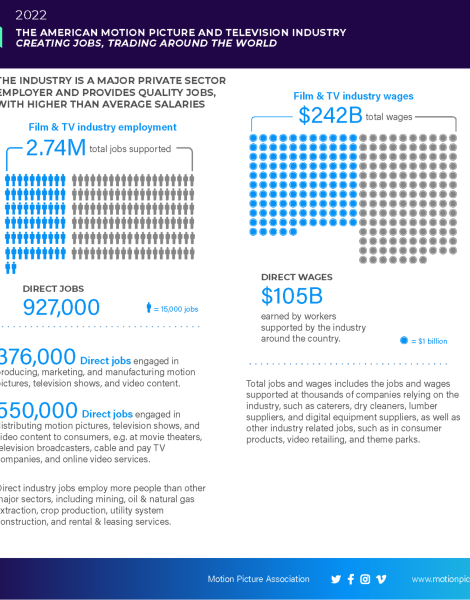
A Global Creative Economy
American storytelling is enjoyed by audiences around the world, accounting for $14.4 billion annually in exports and registering a positive trade balance with nearly every country in the world.
To maintain our competitiveness and reach global audiences, we need open access to markets around the world via forward-looking trade policies that reduce trade barriers, address intellectual property theft, and improve international copyright laws.
More than 70 percent of global box office sales come from international markets.
More of What We Do
Production incentives.
America’s film and television industry creates and embraces new advances in technology—both in how we tell stories and how we engage audiences. Innovations in filmmaking transport audiences to new worlds and deliver content where, when, and on any device they want.

Sign Up For Updates
To stay up to date with the Motion Picture Association, please sign up for our newsletter.
To read this content please select one of the options below:
Please note you do not have access to teaching notes, film-induced tourism: a consumer perspective.
Contemporary Approaches Studying Customer Experience in Tourism Research
ISBN : 978-1-80117-633-0 , eISBN : 978-1-80117-632-3
Publication date: 8 August 2022
Films are arguably one of the most influential phenomenon of modern society. They are remarkable and effective means of conveying stories and influencing humans. Films are one of the most important factors that motivate people to travel to a destination. This chapter will explore the phenomenon which is widely known as film tourism and its role in tourist experience. To gain a better understanding of film tourism experiences, this chapter presents key concepts and analyzes existing studies. The analysis investigates important aspects of film tourism experience, including experience satisfaction and storytelling. It tries to highlight how films can influence tourist experiences beyond the travel itself, with a strong emphasis on the role of storytelling and film tourism experience satisfaction. To help readers achieve a clearer and more detailed understanding of the unique and dynamic nature of film tourism experiences, this chapter provides an overview of the tourist experience by conducting a comprehensive literature review on the subject. By doing this, this chapter proposes a new framework of film tourist experience satisfaction while describing the relationship between influential factors such as previous film experiences, motivation to visit a destination, destination expectations, on-site destination experience, and tourist involvement. Finally, conclusions are drawn presenting storytelling as a contemporary approach in the domain of film tourism experiences.
- Film tourism
- Movie-induced tourism
- Tourist experiences
- Experience satisfaction
- Storytelling
- Consumer experience
Oshriyeh, O. and Capriello, A. (2022), "Film-Induced Tourism: A Consumer Perspective", Jaziri, D. and Rather, R.A. (Ed.) Contemporary Approaches Studying Customer Experience in Tourism Research , Emerald Publishing Limited, Leeds, pp. 223-244. https://doi.org/10.1108/978-1-80117-632-320221022
Emerald Publishing Limited
Copyright © 2022 Omid Oshriyeh and Antonella Capriello. Published under exclusive licence by Emerald Publishing Limited
We’re listening — tell us what you think
Something didn’t work….
Report bugs here
All feedback is valuable
Please share your general feedback
Join us on our journey
Platform update page.
Visit emeraldpublishing.com/platformupdate to discover the latest news and updates
Questions & More Information
Answers to the most commonly asked questions here
Why Film Tourism Is in Vogue [2023 Study]
We’ve all fallen in love with a TV show or movie at least once.
Whether it’s Harry Potter, The Walking Dead, or Breaking Bad, there’s something about getting sucked into a good story that makes you feel warm and fuzzy inside.
Did you ever consider traveling to a place you saw on Netflix?
If so, you aren’t alone.
That’s because film tourism (also known as film-induced tourism, screen tourism, and set-jetting) has been all the rave lately, with more and more people planning vacations around their beloved shows and movies.
So at PhotoAiD, we’ve decided to reach out to 1,000+ Americans to unpack their experiences with this phenomenon, their attitudes toward it, and much more.
Let’s dive right in:
Key Takeaways

- 96% of Americans have visited places associated with their favorite television shows or movies at least once in their lifetime.
- 78% of travelers are likely or very likely to opt for TV- or movie-themed trips in 2023 and beyond.
- The most common reason to engage in film tourism ( 35% ) is to enjoy an immersive experience that lets you live out shows’ or movies’ storylines and follow in the footsteps of famous characters.
- Lodging is the most frequently mentioned film tourism expense ( 60% ), followed by transportation ( 53% ) and sightseeing ( 50% ).
- Globally, the UK and Ireland are the most desirable screen tourism destinations owing to the success of Harry Potter.
- Thanks to the Jurassic Park franchise, Hawaii was picked as the US’ most desirable film tourism destination, according to 31% of respondents.
- 68% of Americans have a negative or very negative attitude toward fellow travelers striking irreverent poses or otherwise misbehaving when visiting the sites of actual tragic events depicted in shows or movies.
Film Tourism Is Gaining Momentum
For starters, we wanted to gauge the popularity of film tourism in the US at the end of 2022.
It turns out 96% of Americans have visited places associated with their favorite television shows or movies. This includes locations and destinations, popular due to their appearance on TV or themed sites built upon the fictional world.
Although we expected the number to be high, we had no idea it’d be THAT high.
It may be because we’re watching more TV than ever before, with the average person likely to stream 437 hours of content in 2023 (=18 full days).
Here’s also a look at the extent to which respondents’ favorite movie or show was a reason to visit a particular spot:
At this point, we also decided to ask survey takers to rate their most recent screen tourism experience.
About four in 10 Americans (42%) consider it positive, and 31% describe it as very positive. As a follow-up, we asked respondents how likely they are to pick one of their next vacation destinations based on their favorite TV show or movie in 2023 and beyond.
The results are in:
As you can see, 78% of Americans are likely or very likely to opt for TV- or movie-themed trips in the upcoming years.
Thus, it’s not surprising that companies like Airbnb and Netflix have already started to capitalize on the opportunity.
The former has launched thematic accommodation options based on Scooby Doo, Moulin Rouge, and Queer Eye. In turn, Netflix partnered with the UN World Tourism Organization (UNWTO) to “help destinations realize the potential benefits of screen tourism.”
Even governmental bodies aren’t lagging.
In fact, the official “Visit Albuquerque” site makes it easy for Breaking Bad fans to plan location tours and visit popular spots, such as Los Pollos Hermanos, Walter White’s house, and the car wash.
That shows just how much the likes of HBO and Apple TV are changing the tourism industry and travelers’ habits.
Scroll on to see what’s fueling this trend.
Key Reasons to Engage in Screen Tourism
People travel for all sorts of reasons.
Some want to check off their travel bucket list. Others are looking to dive under the radar and escape it all.
When it comes to film tourism, here are the TOP five motivators, according to our respondents (the text version is below, just in case):

The data shows that the most common reason to engage in film tourism (35%) is to enjoy an immersive experience that lets you live out your favorite shows’ or movies’ storylines and follow in the footsteps of famous characters.
It’s closely followed by the desire “to experience the city’s scenery shown in the movie or TV show” at 34.9% and to visit depicted restaurants, as 34.4% of respondents indicated.
These make sense, particularly if you consider TV shows.
Their slow-paced plot progression, long runtime, and character development often foster a deep connection between the viewer and the story.
It’s no wonder many people want to go and see the spots on their own.
Top Film Tourism Destinations, Ranked
So far, so good.
Now that we’ve answered some of the why questions, let’s move on to the where part.
To uncover the most desirable film tourism destinations in North America, we gave respondents a list of places famous because of a movie or TV show and asked them to indicate which one was their favorite OR which they’d like to visit the most.
Below are the results:
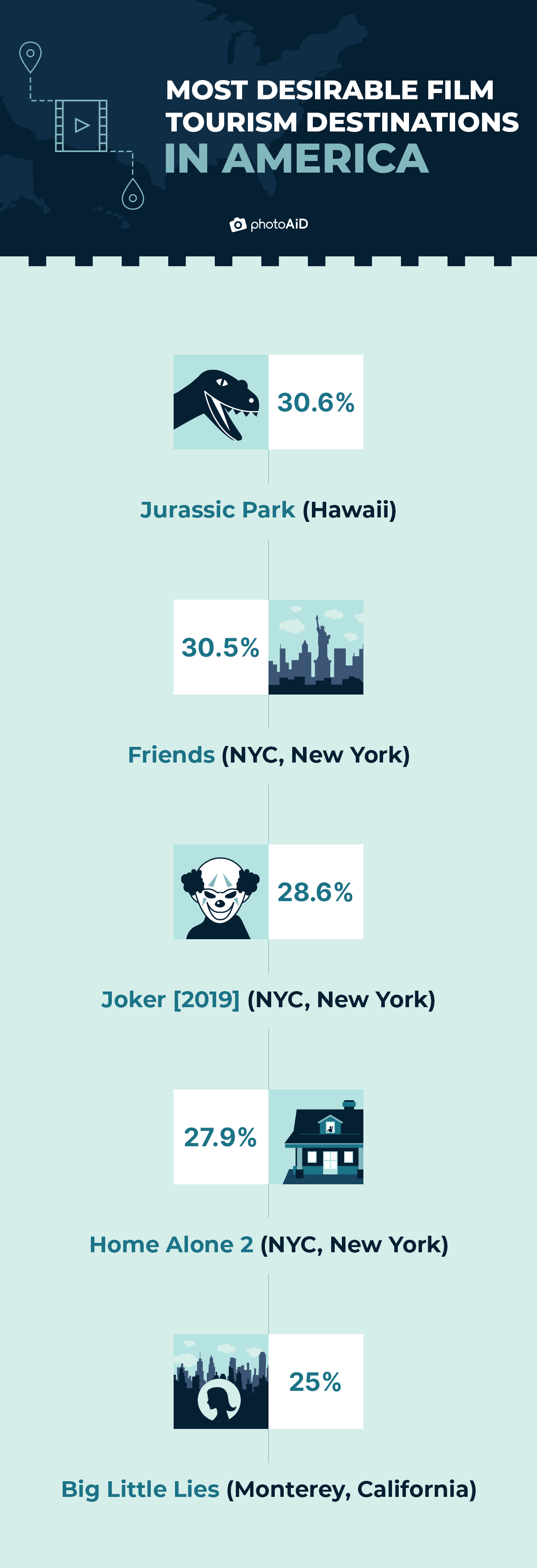
Thanks to the Jurassic Park franchise, Hawaii was picked as the most desirable film tourism destination in the US, according to 30.6% of respondents.
How does it translate into real numbers?
Consider this:
Jurassic World: Fallen Kingdom alone has given Hawaii’s economy a $31M boost and more than $6.9M in wages to 1,200+ Hawaii workers.
So you could say the movie has had a T-Rex-sized impact on the islands.
We also wanted to unveil the most desirable screen tourism destinations globally. Like last time, we gave respondents a hefty list of places and prompted them to make a pick.
See the TOP five results below:
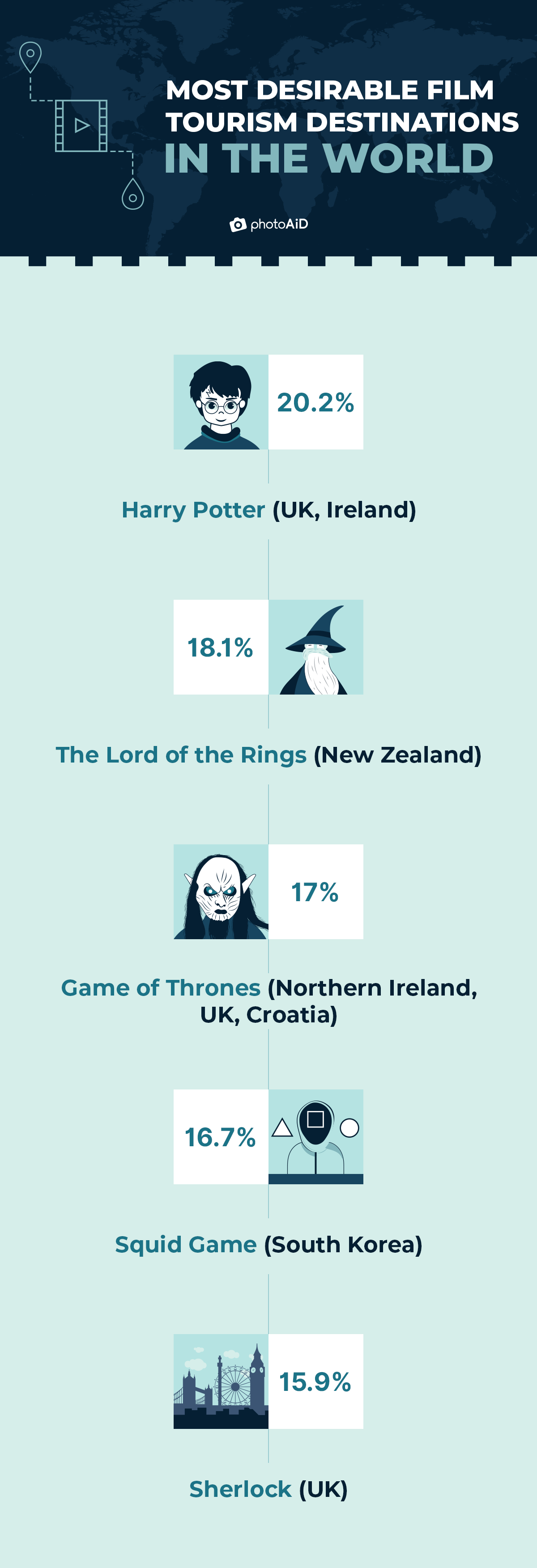
The UK and Ireland took the cake as the most desirable screen tourism destinations globally (20.2%), thanks to Harry Potter. It’s followed by New Zealand courtesy of The Lord of the Rings trilogy. Northern Ireland, the UK, and Croatia close the top three owing to Game of Thrones’ success.
Needless to say, all the destinations saw a significant, lasting increase in demand after said movies and TV shows came out.
To this day, tourists take photos at London King’s Cross railway station, famous for featuring a fictional section known as platform 9¾ in Harry Potter and the Sorcerer’s Stone.
Biggest Expenses Associated with Screen Tourism
Travel isn’t exactly cheap these days.
A pilot shortage, COVID-19-induced demand for travel, and higher fuel prices have all contributed to the recent rise in tourism costs.
So much so that ~9 in 10 vacation-goers (88%) had to downgrade their vacation plans in 2022, according to one of our recent studies.
That’s why we wanted to ask the respondents about their biggest expenses regarding film tourism.
As you can see, lodging was the most frequently mentioned expense (60%), followed by transportation (53%) and sightseeing (50%).
If you plan to fly thousands of miles to get epic Instagram snaps from Squid Game in South Korea, be prepared to open your wallet a little wider.
The Dark Side of Film Tourism
It’s no secret:
Many popular movies and TV shows depict or are based on true events. As a result, some locations can grow popular among travelers.
BBC’s Poldark is a good case in point.
While the series boosted Cornwall’s economy, influencing 14% of all visitors to the county, it also gave rise to the so-called “Poldark effect.”
The phenomenon caused bumper-to-bumper traffic making some communities feel unsafe, and potentially affected the sense of the Cornish identity.
Our study also wanted to see if Americans know that film tourism can cause over-tourism to some of the most in-vogue destinations.
A total of 95% of respondents do.
Although we were pleasantly surprised by such a high number, it’s important to remember that awareness doesn’t always translate into action (after all, the “Poldark effect” came about for a reason).
Now, as our last question, we asked the survey participants about their attitude toward fellow travelers striking irreverent poses or otherwise misbehaving when visiting the sites of actual tragic events featured in a movie or TV show (e.g., Chornobyl).
The takeaway?
Always respect the site’s rules and only take pictures when allowed. Otherwise, you won’t only make others blow a fuse but also give film tourism a bad name.
Stacking It All Up
There you have it.
A comprehensive look at screen tourism to help you stay ahead of the curve.
Did you ever engage in film tourism? Which TV or movie universe would you want to travel to?
Let us know in the comments below.
Methodology
We conducted an online survey of 1,060 US respondents via a bespoke online polling tool in October 2022.
The respondents were 66.8% male and 33.2% female. 7.6% of respondents were 25 or younger, 70.01% were aged 26–38, 17.1% were aged 39–54, and 5.2% were 55 or older.
This survey has a confidence level of 95% and a margin of error of 3%. Given the gender and age makeup of our sample size, the study’s findings are statistically significant for the population at large.
This study was created through multiple research steps, crowdsourcing, and surveying. Data scientists reviewed all survey participants’ responses for quality control. The survey also had an attention-check question.
Fair Use Statement
Did our findings help you learn more about film tourism? If you believe your audience will be interested in this information, feel free to share it. Just remember to mention the source and link back to this page.
- Commisso D., “Here’s What Watching TV Looks Like for Americans Today”
- Ellison J., “How the Pandemic Propelled the Rise of Television Tourism”
- Globetrender, “Airbnb Unveils Scooby Doo, Queer Eye and Moulin Rouge Stays”
- Goel S., “Blockbuster Movies Create Booms for Tourism — and Headaches for Locals”
- Mason E., “‘Poldark’, ‘Peaky Blinders’ and 6 Historical TV Shows That Bring Tourists to Britain”
- Pitner D., “‘Jurassic World: Fallen Kingdom’ Had a Dinosaur-Sized Impact on Hawaii’s Economy”
- Tuclea C., Nistoreanu P., “How Film and Television Programs Can Promote Tourism and Increase the Competitiveness of Tourist Destinations”
- UNWTO, “UNWTO and Netflix Partner to Rethink Screen Tourism”
- Vayntraub A., “Average Person Expects to Stream This Many Different Movies or TV Shows Yearly”
- Visit Albuquerque, “Sightseeing in Albuquerque, New Mexico”
- Woolf M., “The Impact of Inflation on Tourism and Travel [2022 Study]”

As a Digital PR specialist and a member of the Society of Professional Journalists (SPJ), I have 5+ years of writing experience. Over the course of my career, my work has garnered significant attention, with features in numerous prominent publications such as The New York Times, Forbes, Inc., Business Insider, Fast Company, Entrepreneur, BBC, TechRepublic, Glassdoor, and G2.
- Share full article
Advertisement
Supported by
Oklahoma’s Booming Film Industry Has Texas’ Attention
To attract movie and television production, states must try to offer the best incentives. The competition drives spending on Hollywood subsidies ever higher.

By Matt Stevens
Matt Stevens reported from Oklahoma City and its surrounding area, visiting the Capitol, several studios, a live film set and celebrity buffaloes in Indian Country.
For a very brief moment, Taylor Sheridan’s hit television series starring Sylvester Stallone had the working title “Kansas City Mob.” But at the time, Missouri had no state funding for film subsidies.
“Tulsa King” was born.
“We had the incentive, so we got the name,” said Rachel Cannon, the founder of Prairie Surf Studios in Oklahoma City, where much of the show’s first season was filmed.
As Oklahoma poured more and more funding into its rebate program , major productions came to collect. The incentives helped attract “Killers of the Flower Moon,” an Oscar nominee for best picture, and the popular television show “Reservation Dogs.”

Eventually, Oklahoma’s program grew to $30 million, slightly more money on an annual basis than what was being offered in the much larger state of Texas. Famous Texans noticed, successfully urging lawmakers last year to increase funding for the program to $200 million for the next two years, from $45 million. Now, Oklahoma is pursuing legislation that would more than double its offerings.
And that is how the Red River Rivalry spilled over from football to film.
“They’ve got a good thing going,” the actor Dennis Quaid, a Houston native, said in an interview about Oklahoma and its film incentives. “But there’s no reason why competition can’t be healthy for everybody.”
Economists say the fear of falling behind is a key reason that states continue to set aside money for Hollywood subsidies even though they have a poor return on investment . States have spent more than $25 billion as part of the rough-and-tumble fight to win projects.
It can be particularly hard to stand out when a neighbor offers a more lucrative deal. Under mounting pressure from New Jersey, which hopes to attract a Netflix production hub , New York recently expanded its film incentive program to $700 million a year from $420 million.
A similar border war is brewing in Oklahoma. When Mr. Quaid, Matthew McConaughey, Glen Powell, Woody Harrelson and Owen Wilson joined forces in a video last year to call on Texans to support more funding for film and TV, they took a few playful jabs at Oklahoma, which is preparing its counterpunch.
“Thirty million is not enough,” Lt. Gov. Matt Pinnell, who has been pushing a bill that would pump up Oklahoma’s incentives to $80 million annually, said in an interview in his office. A separate legislative effort would add many millions solely for episodic television series that include a live studio audience.
“We have to stay competitive,” he said.
How much money have states been spending?
Over the last 20 years, states have given movie and television productions more than $25 billion in filming incentives. Thirty-eight states currently offer some form of incentive. Georgia’s lauded program has poured more than $5 billion into Hollywood since 2015. New York has spent at least $7 billion, and California has dedicated more than $3 billion to try to retain productions.
Why do states want to encourage filming?
Supporters of film incentives see them as an engine for job creation. After all, when productions come to town, they need electricians, hair stylists and many other crew members to make movie magic. Productions also spend money while working — money that trickles through local economies to hotels, diners and dry cleaners.
Are there any downsides?
Incentives can be effective at luring projects. But economists warn that using them to do so is very expensive and offers minimal bang for your buck. Study after study has found that the tax revenue generated by film incentive programs is a quarter, or even a dime, of every dollar invested. In some programs, each job that is directly created can cost taxpayers more than $100,000.
And yet states are handing out cash?
Incentives come in different forms. Many states do offer cash rebates or grants, which are paid out directly to production companies. Other states give some form of a tax credit. Depending on the state, tax credits can be used toward tax liability, converted into a refund or sold.
Wait, studios sell their tax credits?
Yes. Many states offer a transferable tax credit. Studios can then sell those credits to companies with high state-tax liabilities. By selling them, often at a slight discount, studios can cash out and buyers can receive modest tax relief. As a result, companies with minimal ties to the entertainment industry have become a hidden part of the incentive ecosystem.
Who’s buying these credits?
Companies like Best Buy, U.S. Bank and Dr Pepper buy these tax credits from productions. High-net-worth individuals also sometimes purchase them. Consider one example: The production company behind “The Trial of the Chicago 7” received a $5.2 million tax credit from New Jersey that it sold to Apple Inc. for $4.8 million.
Can we track where all this money is going?
It’s hard. This process involves vast sums of tax revenue that states are owed but never collect. Because the money does not come into the state treasury to begin with, it is less obvious that the revenue has been lost. And that can make transferable tax credits politically palatable.
For many years, the arid plains and wide skies of Oklahoma did not radiate Hollywood dynamism. But the state is a birthplace of boom , one with an unending appetite for opportunity. So Oklahoma made a major bet on filming incentives.
“Killers of the Flower Moon” has received more than $4 million in incentives for filming in the city of Pawhuska , with more payments pending. “Reservation Dogs” filmed a pilot and three seasons in and around Okmulgee with the help of $12.8 million in state funding, and “Tulsa King” got a $14.1 million rebate for the episodes it filmed in Oklahoma City.
Film and TV enthusiasts in Oklahoma insist there is plenty of room for more.
In recent months, the anticipated summer blockbuster “Twisters,” a reboot of the 1996 movie “Twister,” took over Prairie Surf, which has 1.3 million square feet of production space in Oklahoma City’s former convention center.
“The only way that I lose is if we don’t have enough money to offer,” said Ms. Cannon, who has a framed editorial cartoon involving tax credits and Mr. Stallone hanging in her office.
The Cherokee Nation, in northeastern Oklahoma, has also decided that film is a good investment. It has a film office, a cutting-edge soundstage and an incentive program .
“When we bring films here, Georgia strikes out or Texas strikes out,” said Chuck Hoskin Jr., the principal chief of the Cherokee Nation. “And if you’re from Oklahoma, you really want Texas to come in second .”
The film industry, emphasizing the potential return on investment, says states are competing for an industry that creates good jobs and bolsters the local economy.
“The fact that 38 states have implemented programs with bipartisan support to incentivize film, television and streaming productions is because of the industry’s proven economic impact,” Kathy Bañuelos, a senior vice president at the Motion Picture Association, said in a statement.
Andrea Sporcic Klund, the director of the Missouri Film Office, knows what it feels like to not be one of the 38. For years, the state smarted over the fact that “Ozark,” the Netflix hit featuring the Lake of the Ozarks, was filmed in Georgia.
Ms. Sporcic Klund said that at one trade show, she and her colleagues began making red marks every time someone asked whether Missouri had filming incentives.
“It was pages and pages of tally marks, and it was a conversation ender,” she recalled. “We would say, ‘We don’t have an incentive,’ and they would walk away.”
By 2023, after missing out on both “Ozark” and “Tulsa King,” Missouri lawmakers had passed the Show MO Act , which restarted the state’s dormant film and TV incentive program.
Now it is Oklahoma that has been left at the altar. The second season of “Tulsa King” will be filmed primarily in Atlanta , in a state with an uncapped tax incentive program .
Showrunners did not choose Tulsa strictly because of Oklahoma’s rebate program, according to an executive connected to the show, who asked to remain unidentified to share insight into sensitive discussions. And the decision to move to Georgia, the executive said, was made mostly because actors and crew members are more readily available there.
Ms. Cannon was left with the impression that the move was largely a financial one.
“They didn’t give us a reason they chose not to stay,” she said, “other than I know they didn’t get enough money back.”
Oklahoma also increasingly has to worry about movies and shows being lured by Texas, which is doing what it does best: Building big.
Last year, Stray Vista Studios , the state’s largest space for virtual production, opened in Dripping Springs, 25 miles west of Austin. Hill Country Studios, a 200-acre production hub in San Marcos, is expected to open its first seven soundstages next year. And a 600-acre project in Bastrop , an hour’s drive from San Marcos, is on the way, too.
“ Most Texans like to be bigger and better than everybody, not just Oklahomans,” said Four Price, a House member who last session sponsored an unsuccessful bill that would have created an entirely new incentive program.
Supporters of that effort say it would create more stable funding, in part by giving productions transferable tax credits. (The state’s current program uses cash grants.) A fresh video from famous Texans will appear soon, said Chase Musslewhite, who is helping lead a coalition called Media for Texas. By 2025, she hopes to have a new bill to put in front of the Legislature.
How much funding will the group seek?
Ms. Musslewhite noted that Georgia’s program has no cap, and that New York and California are able to spend hundreds of millions of dollars each year. “So we would want to be in that realm,” she said. “To be as competitive as that would be the goal.”
Mr. Quaid was more precise.
“The next time we come back,” he said, “we’re going to ask for $1 billion.”
Matt Stevens writes about arts and culture news for The Times. More about Matt Stevens
Movie theaters make plea for more films, rail against piracy at CinemaCon 2024

- Show more sharing options
- Copy Link URL Copied!
Somehow, heartbreak feels good in a place like CinemaCon — where no matter how many hits the motion picture industry has taken over the last year (and, uh, it’s taken a lot ), exhibitors from all over the world unfailingly come together to exude enthusiasm about the moviegoing experience and optimism about the future of cinema .
Flag bearers for the Motion Picture Assn., the National Assn. of Theatre Owners and other major industry players convened Tuesday at Caesars Palace in Las Vegas to deliver their annual state-of-the-business address and officially kick off the event. Movie stars, filmmakers and studio heads are expected to tease, extol and in some cases screen their upcoming releases.
There’s a lot riding on those movies in the wake of a box office slump partially brought on by the Hollywood writers’ and actors’ strikes, which delayed several movies and effectively halted film and TV production last year for about six months.

Company Town
Movies are back? At CinemaCon, theater owners and studios will make the case
CinemaCon, the annual film industry conference in Las Vegas, is set to rally support for theaters amid a thin 2024 box office slate.
April 9, 2024
“We can’t shy away from the stark challenges of this moment, nor can we ignore this time of volatility in our industry,” said Charles Rivkin, chief executive of the MPA, during Tuesday’s presentation. Washington-based MPA represents the Hollywood studios, including Disney and Netflix.
“Yet no one should fear that uncertainty,” he added, “because after all, we work in a business where unexpected twists can make for an epic story. ... We understand the stakes. We recognize the need to do everything possible to ensure the enduring health of cinema.”
Global box office revenue is predicted to hit $32 billion in 2024, according to film analytics firm Gower Street, which is nowhere near the $40-billion-plus heights of the pre-COVID-19 era. But since the beginning of 2024 — when domestic box office revenue was down 20% from the previous year — some glimmers of hope have emerged.
In March, the highly anticipated sequel to Warner Bros.’ “Dune” launched at $82.5 million in the United States and Canada — the first true blockbuster opening weekend since AMC Theatres’ “Taylor Swift: The Eras Tour” ($93.2 million).

Oscars mark last hurrah for ‘Barbenheimer’ as 2024 box office faces uncertain future
This year’s Oscar nominees did strong business at the box office. But the year ahead is uncertain after a shaky winter.
March 9, 2024
Following the desperately needed success of “Dune: Part Two” — which has now grossed more than $255 million domestically — Universal Pictures’ “Kung Fu Panda 4” notched a solid $58-million domestic debut, Sony Pictures’ “Ghostbusters: Frozen Empire” posted a decent $45 million and Warner Bros.’ “Godzilla x Kong: The New Empire” drew an impressive $80-million bow.
Exhibitors on Tuesday also touted the rising popularity of Japanese cinema in the United States, including Crunchyroll-distributed anime hits such as the latest “Demon Slayer” movie and Toho Co.‘s Oscar-winning “Godzilla Minus One.”
Mitchel Berger, senior vice president of global commerce at Crunchyroll, said Tuesday that the global anime business generated $14 billion a decade ago and is projected to generate $37 billion next year.
“Anime is red hot right now,” Berger said.
“Fans have known about it for years, but now everyone else is catching up and recognizing that it’s a cultural, economic force to be reckoned with.”

Box office outlook for 2024: Lowered expectations, but don’t count out wild cards
The box office in 2024 is expected to come in at around $8 billion in the U.S. and Canada, or $1 billion lower than last year. But movies themselves can still be healthy.
Jan. 3, 2024
Exhibitors are hoping that momentum holds despite also weathering several recent box office disappointments, such as Universal Pictures’ misbegotten spy thriller “Argylle” and Sony Pictures’ superhero disaster “Madame Web.”
When the actors’ strike concluded in November, theater operators expressed concerns about the health of the 2024 film slate. The overlapping work stoppages prompted studios to push at least a dozen movies to 2025 from 2024, including the eighth installment in Paramount Pictures’ “Mission: Impossible” saga and Disney’s live-action remake of “Snow White.”
Cinemark Chief Executive Sean Gamble estimated in February that 95 pictures were slated to open this year in wide release, as opposed to 110 in 2023. And nothing spells danger for exhibitors like a thinned-out release schedule. It doesn’t help that the average length of the theatrical window significantly shrank (from 90 days to roughly 35 to 40 days) after the COVID-19 pandemic shut down movie theaters for more than a year.

Entertainment & Arts
Box office doldrums continue, but ‘Dune: Part Two’ looms on the horizon
“Bob Marley” One Love” stays strong, but “Ordinary Angels” and “Drive-Away Dolls” kept audiences away at the weekend box office.
Feb. 25, 2024
At Tuesday’s presentation, exhibitors pleaded with distributors to take a leap of faith and commit to releasing movies in cinemas year-round — not just during times that have historically seen heavier foot traffic.
“For my friends in distribution, please embrace digital’s flexibility and offer your awe-inspiring movies 52 weeks of the year to every exhibitor,” said Chris Johnson, CEO of Classic Cinemas. “Eliminate print counts and trust us to make programming and scheduling decisions that yield the best results for all. ... If you have a hit, we will hold it.”
Michael O’Leary, CEO of the National Assn. of Theatre Owners, also made the case for more small- and medium-budget releases that attract cinephiles, citing prestige titles such as A24’s “Past Lives” and Amazon MGM Studios’ “American Fiction.”
“It’s not enough for us to simply sit back and want more movies,” O’Leary said. “We must work with distribution to get more movies of all sizes to the marketplace.”

AMC Theatres shares plummet as theater chain reels from box office struggles
AMC Entertainment shares fell about 15% shortly after the theater chain indicated that it could sell up to $250 million worth of stock to pad its finances after a period of box office woes.
March 28, 2024
This year, a number of potential upcoming blockbusters remain.
Universal is cooking up “Twisters,” “Wicked” and “Despicable Me 4”; Warner Bros. is sitting on “Furiosa: A Mad Max Saga,” “Joker: Folie à Deux” and “Beetlejuice Beetlejuice”; Paramount is distributing “Gladiator 2” and “A Quiet Place: Day One”; Sony is launching “Venom: The Last Dance”; Disney is set to release “Inside Out 2,” “Moana 2” and “Deadpool & Wolverine”; and Amazon MGM Studios is about to drop “Challengers,” starring Zendaya.
The last few years at CinemaCon have drawn battle lines between exhibitors and streamers. During the streaming wars of 2021 and 2022, studios threw an excessive amount of resources and funds at streaming projects in an effort to compete with Netflix.

CinemaCon 2023: ‘The Flash’ screens, Hollywood disses streaming
CinemaCon in Las Vegas highlights the movie theater industry’s ongoing recovery, with stars and studios committing to exclusive theatrical releases — again.
April 26, 2023
At the time, streaming was painted as theaters’ archnemesis. But the great streaming boom of the early 2020s has subsided as entertainment companies — reeling from financial losses — are tightening their belts and greenlighting less streaming content.
In December, Disney unveiled plans to re-release three Pixar titles — “Soul,” “Turning Red” and “Luca” — in theaters this year after initially routing them directly to streaming. Additionally, “Moana 2” — originally conceived as a TV series to be streamed on Disney+ — was reworked into a feature coming to the big screen in November.
Though streaming undoubtedly still poses a threat to movie theaters, the tides appear to be turning ever so slightly in exhibitors’ favor as studios rethink their release strategies and film fanatics continue to splurge on Imax and other premium large formats.
“You can watch a movie on TV or on your tablet or on your computer, but you experience it in a theater,” O’Leary said. “And part of what makes the movie so special is the theaters themselves.”
Report: Online piracy remains multi-hundred-million-dollar business
Online piracy continues to thrive amid a rise in streaming websites, according to a report released Tuesday by Internet safety organization Digital Citizens Alliance and consulting firm MediaLink.
May 19, 2015
However, exhibitors at CinemaCon did repeatedly express concerns about the rise of illegal streaming and digital piracy. Rivkin condemned the practice as “insidious forms of theft” that harm production workers, actors, directors, writers, craftspeople and even consumers who risk falling prey to malware viruses when watching movies illegally online.
Rivkin estimated that on average, piracy costs the movie theater industry more than $1 billion per year. During his state-of-the-industry address, he called on Congress to enact site-blocking legislation that would prevent internet users in the United States from accessing websites that stream films illegally.
“Piracy operations have only grown more nimble, more advanced and more elusive every day,” Rivkin said. “These activities are nefarious by any definition. They’re detrimental to our industry by any standard. And they’re dangerous for the rights of creators and consumers by any measure.”
More to Read

‘Wicked’ spectacles, merger gossip and movie industry woes at CinemaCon 2024
April 12, 2024

‘Dune 2’ spices up the box office after a months-long dry spell
March 3, 2024

Will a post-strike Sundance see a deal surge? What insiders are saying about the indie film market
Jan. 19, 2024
Inside the business of entertainment
The Wide Shot brings you news, analysis and insights on everything from streaming wars to production — and what it all means for the future.
You may occasionally receive promotional content from the Los Angeles Times.

Christi Carras reports on the entertainment industry for the Los Angeles Times. She previously covered entertainment news for The Times after graduating from UCLA and working at Variety, the Hollywood Reporter and CNN Newsource.
More From the Los Angeles Times

News publishers’ alliance calls on feds to investigate Google for limiting California links

Smartmatic settles defamation suit against right-wing network OAN
April 16, 2024

NPR suspends journalist who publicly accused network of liberal bias
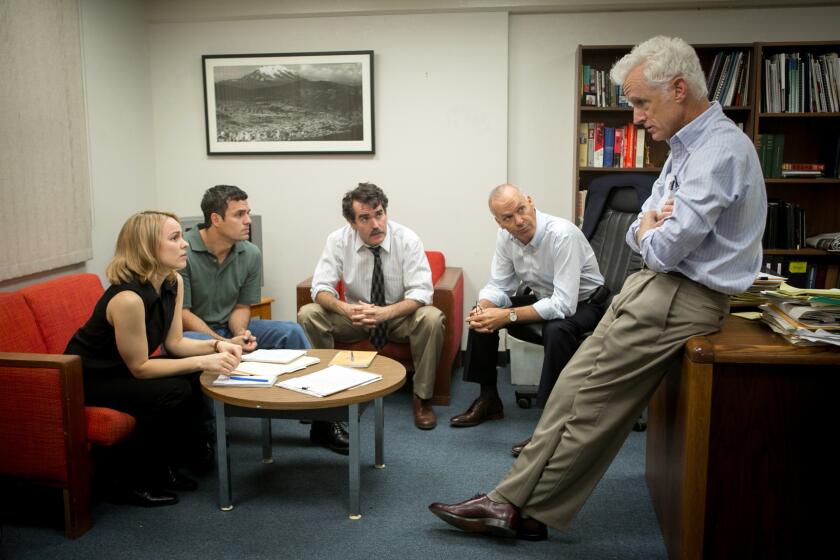
Participant, maker of ‘Green Book’ and ‘An Inconvenient Truth,’ is shutting down

12 Productions Projected to Bring in More Than $1.1 Billion to California’s Economy, Employ 4,500 Cast and Crew
Apr 8, 2024 | Press Release
Amazon MGM Studios’ “Fallout” Among Largest Relocating Series
HOLLYWOOD, Calif. (April 8, 2024) – Today, the California Film Commission (CFC) announced $152 million in tax credits for 12 television projects – one relocating series, three recurring television series, and eight new television series – as a part of its Film and Television Tax Credit Program, including one of the largest relocating series in the history of the program.
These 12 projects will spend an estimated $1.1 billion in California during their upcoming season, supporting in-state local businesses and employing 2,300 crew, 2,200 cast, and 53,000 background performers – the latter measured in days worked. With filming beginning later this year, these projects will offer crucial opportunities for local workers in the industry – projecting an estimated 1,253 filming days in California, including 39 shoot days planned outside of the Los Angeles 30-Mile Studio Zone in Oxnard, Ventura, Lancaster, and San Diego County.
Leading the charge is Amazon MGM Studios’ “Fallout,” which is relocating from New York. Season 2 of “Fallout” is projected to contribute approximately $153 million in qualified expenditures and employ approximately 170 cast and crew, making it one of the relocating projects with the largest total qualified expenditures in the Film and Television Tax Credit Program’s history. Set against the backdrop of post-apocalyptic Los Angeles, this groundbreaking series is coming home for its second season, thanks to this tax credit. With the addition of “Fallout,” the Film and Television Tax Credit Program has now attracted a total of 33 relocating series from other states and nations since the program was launched in 2009. Learn more about our relocating series here .
“Our tax credit program is delivering precisely as intended: attracting and keeping productions filming in California, creating new job opportunities for our workforce, and bolstering our local economies,” said Colleen Bell, Executive Director of the California Film Commission, emphasizing the program’s effectiveness in achieving its objectives. “Additionally, we are thrilled to bring ‘Fallout’ back to its California roots. We take pride in productions choosing to pack up and relocate to our great state from other jurisdictions.”
The roster of new television series includes a wide range of projects from an iconic series franchise to captivating original content. Amazon MGM Studios’ “Untitled Task Force Series” will follow a secret task force of undercover agents, while 20th Television presents two highly anticipated projects by executive producer Ryan Murphy – “Dr. Odyssey” starring Joshua Jackson and “Grotesquerie” starring Niecy Nash. “We are thrilled to film Ryan Murphy’s ‘Grotesquerie’ for FX and ‘Dr. Odyssey’ for ABC in California,” said a 20th Television spokesperson. “It’s incredibly gratifying to keep television production jobs local in California, utilizing the world class crew available here.”
Adding to the lineup is “NCIS: Origins” from CBS Studios, offering viewers a compelling look at the early career of Special Agent Leroy Jethro Gibbs, with narration by franchise favorite Mark Harmon.
“We’ve had the immense privilege to create stories with the talented crews and individuals in California for years,” said ‘NCIS: Origins’ Executive Producers Mark Harmon, Sean Harmon, Gina Lucita Monreal, and David J. North. “With the support of the California Film Commission, we are thrilled to film ‘NCIS: Origins’ in Los Angeles, utilizing all of the fantastic resources, locations and most importantly, the talented people in this city we love and call home.”
Other new television series include two new projects by Warner Bros. Discovery – “Latitude” and “The Pitt” – and two new projects from Faith Media Distribution – “Blood Ties” and “Runaway Girl.” Showcasing California’s versatility across the four series, California is set to play Nebraska, New Jersey, North Carolina, and Pennsylvania. Max Production’s “The Pitt” is a new drama starring Noah Wyle, who will also serve as Executive Producer, delving into the challenges confronting healthcare workers in today’s America.
In addition to the influx of new projects, the Tax Credit Program continues to support three recurring series, which are estimated to spend a combined $178 million in qualified expenditures and employ a total of 1,500 cast and crew. For the full list of ongoing television productions that are a part of the Tax Credit Program, see here .
About the California Film Commission and Tax Credit Program
The California Film Commission enhances California’s status as the leader in motion picture, television and commercial production. It supports productions of all sizes/budgets and focuses on activities that stimulate and preserve production jobs, spending and tax revenues in California. Services include administration of the state’s Film & Television Tax Credit Program, permits for filming at state-owned properties, an extensive digital location library, location assistance and a range of other production-related resources and assistance.
The Film & Television Tax Credit Program provides tax credits based on qualified expenditures for eligible productions that are produced in California. The current $1.55 billion program will run for a total of five years, with a sunset date of June 30, 2025. Governor Newsom signed Senate Bill 132 on July 10, 2023, extending the Program for another five years, through fiscal 2030-31.
Looking ahead, the next application period for television is scheduled for June 3-5, 2024, with approximately $150 million available for distribution. Meanwhile, the next film application window is slated for July 29-31, 2024, with about $80 million available for both independent and non-independent projects. Visit the California Film Commission website for more information.
About California Film Commission The California Film Commission (CFC) is one of several economic development departments within the Governor’s Office of Business and Economic Development working to attract, retain, and expand business opportunities in California. The CFC supports a production-friendly environment to retain and grow production jobs and economic activity statewide, enhancing California’s position as the leading location for all forms of media content creation nationally and globally. For more information visit the CFC website .
Ramona Wright Mozaic Media & Communications on behalf of California Film Commission Email : [email protected] (310) 382-6679
Aram Nadjarian Mozaic Media & Communications on behalf of California Film Commission Email: [email protected] (323) 533-4523
Explore more articles by category: Press Releases | Production Alerts | Newsletters
California Film Commission 7080 Hollywood Blvd., Suite 900 Los Angeles, CA 90028 Tel: 323.860.2960 | 800.858.4749 Email the CFC | About Us
State Programs Register to Vote Statewide Disaster Response Tool California Grants Portal
Download the Cinemascout app!

Leah M. Medrano
This will close in 0 seconds

Eric Klosterman
Permit Manager After a 35-year career as a location manager, Eric brings a wealth of knowledge and problem-solving skills as the Manager for the Permit Department. He served as 2016/17 President of the Location Managers Guild International. He’s a true industry veteran, having worked on many large-scale film and TV productions such as Black Rain, Indecent Proposal, Ghost, Anywhere but Here, ER, and Hart of Dixie .

Erik Deutsch

Joseph Cruz
Before joining the California Film Commission Joseph has also worked for the State of Caifornia Department of Corporations and Department of Social Services. Joseph is a native New Yorker and an alumni of Antioch College and U.S. Navy veteran. Joseph enjoys music, dancing, tennis and volleyball. A favorite quote is: “Anyone who keeps the ability to see life’s beauty never grows old in heart or spirit”

Jennifer Jackson
Jennifer is a valued member of the CFC team having first joined in 2015 as an Administrative Assistant ensuring operations around human resources, purchasing, and travel ran smoothly. She was promoted to Location Resource Coordinator in July of 2022 where she currently assists productions throughout California and maintains CFC assets such as the location library and FLIC contacts across the Golden State.
Jennifer previously worked for the State with the Lanterman Developmental Center, and State Compensation Insurance Fund, in addition to 10 years in advertising sales with the Los Angeles Times, La Canada Valley Sun, and the Glendale News Press.

Laura Baptista
General Assistant Laura’s friendly voice will likely be the one you hear when calling the CFC’s office as she’s stationed at our front desk to handle reception and general office work. She joins us from the California Highway Patrol. She studied Cinema at San Francisco State University and also worked as a TV production assistant. In her spare time, Laura enjoys swimming, DIYing and studying to one day compete on Jeopardy.

Lisa Mosher
Lisa joined the California Film Commission in 1987 after years as a librarian with the Academy of Motion Picture Arts and Sciences and participated in a job exchange program with the British Film Institute. As the manager of the CFC’s Location Resource Center, Lisa supervises the organization of location photographs and contact information to permit offices statewide, while providing location and production assistance. She expanded the CFC’s hardcopy photo library and online location resource – CinemaScout - bringing all resources into the digital age. Recently, Lisa also completed four decades as a part-time librarian with the Beverly Hills Public Library. She holds a USC Master of Science in Library Science and a UCLA Bachelor of Arts in Art History and Film. Working at the CFC alongside expert colleagues, creative film commissioners, and brilliant location professionals is a true calling and the joy of her life.

Jerram Swartz
After spending four decades in the trenches as an Assistant Director and Production Manager, with over 100 credits that include E.T. – The Extraterrestrial, The Blues Brothers, and The Walking Dead , and filming locations throughout the US and Europe, Jerram left the glamor of 16-hour workdays for the comparative sanity of the life of an analyst at the film commission, which he says is “one of the smartest moves I ever made.” Occasional lecturer, also Producer/Director/Lyricist for six seasons of The Pasadena Follies .

Isaiah Sandoval

Francisco Vasquez

Catherine Adamic

David Booth
David is the Permit Coordinator for the Caltrans desk at the CFC. He studied Film and Television Production at San Diego State University, and produced the award-winning shorts, Good Morning, Dave , Four for a Quarter , and the well-received Wordmeister series of educational videos. In his spare time David enjoys refurbishing old spoons and taking correspondence courses in breakdancing.

Brandy Davis
Location Resource Advisor Brandy joined the CFC team in 2018 as the Permit Coordinator for State Beaches, Parks, Buildings and Facilities before being promoted to Location Resource Advisor in March of 2022. She previously worked for State Parks’ Angeles District, where she worked for nearly three years. Before working for the State, she produced several non-fiction programs – from clip shows and talk shows to docu-reality series. Brandy also served as casting director for an independent film and a short film that was part of the AFI Directing Workshop for Women. Brandy graduated from Cal State Northridge with a degree in Cinema & TV Arts.

Officer Ian Ramer
As the California Highway Patrol’s film liaison, Ian Ramer facilitates permitting for film production on roads, highways, freeways and related state property throughout California. He works with CALTRANS, various road authorities, and production companies, to address safety and operational issues involving production activity. Officer Ramer began his current post last December 2017 after transferring to CHP’s Southern Division office earlier that year. He joined CHP in 2007 and has also served as a public safety dispatcher and commercial vehicle inspection specialist.

Richard Schlesinger
Richard brings to the Film Commission over thirty years of experience as a Producer, Executive Producer, Line Producer, Screenwriter and Director. A specialist in international co-production, he has made movies and TV series in 20 countries around the world, as well as many states and provinces in the US and Canada. Seven of his screenplays have been produced. Richard speaks French fluently and has a degree in Film & Literature from Brown University.

Hedvig Marx
Hedvig moved to California in 2018 and has since worked for the State of California as a policy analyst and manager, and most recently in the SAG-AFTRA Residuals Claims Department. Prior to moving to the U.S., Hedvig worked for many years in the live entertainment and cultural heritage sector in Sweden as a project manager and coordinator. Hedvig has an MSSc in Gender Studies, Intersectionality and Change, as well as degrees in English and Cinema History & Theory.

Alfonso Casey
Alfonso is a native of Southern California with twelve years of experience working at one of the largest medical device manufacturers in the world. He graduated with a mathematics degree from Cal Poly Pomona. He enjoys crunching numbers, solving puzzles, basketball, and playing guitar.

Jennifer Fierro
Jennifer is a native Angeleno, born and raised in Angelino Heights. She has worked in State service for about 8 years which started at the State Compensation Insurance Fund back in 2014. Prior to joining the Film Commission, she recently worked at the California Unemployment Insurance Appeals Board. Jennifer enjoys photography, cooking, camping/outdoor activities, and caring for her pet Dachshund, “Churro.” Jennifer enjoys watching classic films, including favorites such as “Casablanca,” “Man on Fire,” “The Outsiders,” and “Reservoir Dogs.”

Shadina Tiffith
Administrative Assistant Shadina joined the CFC team in September of 2022, as an Administrative Assistant. She previously worked in the film industry for Amazon Studios, as an Executive Administrative Assistant. She previously worked for the State of California Employment Development Department, as an Employment Specialist claim filer for several years. Shadina is a great addition to the administrative team. She brings her huge personality, her great customer service skills, along with her team player attitude, and all her wonderful talents, with a great deal of experience in office administration to our team. Shadina studied at Cal State LA, for a degree in Business Administration.

Tiana Reynolds Permit Coordinator Southern California State Parks
Tiana is the Southern California State Parks Coordinator at the CFC. She previously worked as the Film Billing Coordinator for CA State Parks. She graduated from California State University, Fullerton with a BA in Business Administration concentrating in Entertainment & Hospitality Management. In her free time, she likes to spend her time at Disneyland and trivia nights with friends.

Lori Moilov
Permit Coordinator Southern California State Parks
Lori joined the CFC team in 2022 as the Permit Coordinator for State Beaches, Parks, Buildings and Facilities. Before joining the team, she worked at Walt Disney Imagineering helping budget various media projects for the Disney parks as a Bidding Producer. She has worked for several production companies at TBS, TNT, E!, CBS, HBO, Lifetime, BET, Jesse Collins Entertainment, and Animal Planet in production finance. Some shows include Silicon Valley, Angel From Hell, Roadies, The Arsenio Hall Show, BET Awards, Hip Hop Awards, Dirty little secret: Jodi Arias, Wild Recon, I’m Alive, Venom in Vegas, and more. She started in the entertainment industry working for Robert Evans and his production company at Paramount Pictures reading manuscripts and scripts doing development and providing coverage. Lori is a double major in Accounting and Marketing from California State University Long Beach.

Omar Yousif
Program Coordinator
Omar Yousif is the Program Coordinator for the Film and Television Tax Credit Program. Omar brings experience in public relations and various government / non-profit work. He previously worked at Marino, BerlinRosen, and Vote 4 Me. Omar graduated from the University of Southern California, where he studied Public Relations and Political Science.

Lorna Leslie
Lorna comes to the CFC after a long career as a Camera Assistant on Film, TV and Commercials projects. She has been living in Agua Dulce for almost 20 years. She has four chickens, two pygmy goats, and a dog named Chappie. She enjoys participating in community activities, volunteering, and spending time in the great outdoors. Also, she is a mixed media artist and sells some of her artwork in local shops.

Fanshen Cox
Diversity, Equity, Inclusion, and Accessibility Initiative Manager
Fanshen is the former SVP Development & Impact at Pearl Street Films. She holds an MFA from CalState LA and an honorary MFA from New York Film Academy. She’s an award-winning playwright, and is the producer and host of the Sista Brunch podcast - sharing the stories of Black women and gender expansive people thriving in entertainment and media. Fanshen is also a co-author of the Inclusion Rider, and founder of TruJuLo Productions which uplifts stories that speak truth in pursuit of justice, in service of love.

Megan Fleming
Program Assistant
Megan worked in film & television development at companies such as The Safran Company for seven years before coming aboard as the Program Assistant at the California Film Commission Tax Credit Program. She is originally from Lawrence, Kansas and graduated from University of Nebraska-Lincoln with a degree in Film and New Media.

IMAGES
VIDEO
COMMENTS
Film tourism has a role to play in local economic development in at different levels and in various types of environment. The role of film in cities. Frost (2009); Kostopoulou et al. (2011); Stringer (2001) The development, significance and economic impact of film festivals.
- The purpose of this paper is to highlight the potential of film‐induced tourism to provide sustained economic contribution to destinations., - The paper takes the form of a literature review and identifies the economic contribution made by film‐induced tourism., - It is observed that film‐induced tourism only provides a sustained ...
The tourism economy has become a new driving force for economic growth, and film-induced tourism in particular has been widely proven to promote economic and cultural development. Few studies focus on analyzing the inherent characteristics of the economic and cultural effects of film-induced tourism, and the research on the dynamic mechanism of ...
Studies have examined the influence of film tourism on the economy and residents; they often focus on carrying capacity and increased visitor numbers (Frost, 2006; Kim et al., 2009). There has also been some limited research on how films negatively portray a destination's image (Pratt, 2015).
Film Tourism: Sustained Economic Contributions to Destinations Croy, W. Glen. "Film Tourism: Sustained Economic Contributions to Destinations." ... "Film Tourism Planning and Development—Questioning the Role of Stakeholders and Sustainability." Tourism and Hospitality Planning & Development, vol. 7, no. 1, Mar. 2010, pp. 31-46.
Film tourism, or film induced tourism, is a specialized or niche form of tourism where visitors explore locations and destinations which have become popular due to their appearance in films and television series. The term also encompasses tours to production studios as well as movies or television-related parks. This is supported by several regression analyses that suggest a high correlation ...
The economic impact of film induced tourism is of great interest to governments, tourist authorities, local businesses as well as residents. Film tourism reveals a positive economic impact on a ...
According to Figure 3, the main studies have focused on film destination (21.2%), followed by marketing (16.9%), film-induced tourism (16.1%) and destination image (14.4%). Research has been growing significantly since the 1970s, reaching a peak in 2011. In recent years we have seen a decrease in research.
The economic impact of film induced tourism is of great interest to governments, tourist authorities, local businesses as well as residents. Film tourism reveals a positive economic impact on a … Expand. 2. 1 Excerpt; Save. Films and Destinations - Towards a Film Destination: A Review.
Film Tourism. Film tourism and its related tourism concepts that include the effects of TV, films, movies and media culture has become more popular, and discussions surrounding this topic include research into economic impacts (Tooke and Baker, Citation 1996), marketing and product placement (Hudson and Ritchie, Citation 2006a, Citation 2006b), motivation of tourists (Busby and Klug, Citation ...
Factor analysis reveals four types of marketing activities in which destinations can engage to promote film tourism: proactive efforts to encourage producers and studios to film at the location, efforts to generate media publicity around the film and its location, marketing activities that promote the film location after production, and ...
The emerging field of film tourism research invites multi-disciplinary post-modern study, which has moved from simply considering business and marketing aspects towards approaches incorporating multiple disciplinary perspectives. In her paper in this edition, Angelina Karpovich frames this by examining the range of terms used to describe the ...
Insights ›. Transforming location into vacation - A report on film tourism. The report emphasises the need for India to leverage its abundant cinematic heritage and diverse landscapes to position itself as a leading film-tourism destination, thereby contributing to its economic growth and cultural preservation. It highlights the current state ...
Sue Beeton's Film-Induced Tourism, published in 2016 as part of Channel View's "Aspects of Tourism" series, is a much needed update from the original 2005 first edition.Film tourism now receives much greater attention, also due to its increasing popularity amongst visitors that extends so far that some destinations are struggling to cope with tourist demand.
Past research has confirmed film tourism emerging as a major growth sector for research in tourism and a driver of tourism development for many destinations. ... W. G. (2011). Film tourism: Sustained economic contributions to destinations. Worldwide Hospitality and Tourism Themes, 3(2), 159-164. Article Google Scholar Croy, W. G., & Heitmann ...
Film-Induced Culture and Tourism Industry. Film-induced culture plays a vital role in the global advertisement system. It is an effective approach for the advertisement of regional values and soft power, and it is a good pathway for cultural output and value proposition (Yi et al., 2020).With the advance of economic development, consumers have broken the restrictions of basic needs spending ...
Economic and social changes have had dramatic effects on regional areas. In a search for diversification, tourism and film may be targeted by these regions. Challenges of regional planning, however, include lack of local expertise, decentralized decision making, and diverse stakeholder groups. Specifically for film tourism this includes anticipating visitation numbers and assessing potential ...
March 06, 2024. The American film and television industry supports 2.74 million jobs, pays out $242 billion in total wages, and comprises more than 122,000 businesses—according to an analysis of the most recent economic figures released by the Motion Picture Association. For a more detailed analysis of the industry's economic impact ...
tourism, but it is difficult for us to quantify it ( Busby & Klug, 2001). The number of tourists coming to. tourist destinations motivated by film tourism in 2012 reached 40 million tourists, w ...
Similarly, the " Harry Potter " film franchise caused tourism to increase at least 50% to every U.K. location where the movies were filmed, according to an article in the Journal of Travel ...
The analysis investigates important aspects of film tourism experience, including experience satisfaction and storytelling. It tries to highlight how films can influence tourist experiences beyond the travel itself, with a strong emphasis on the role of storytelling and film tourism experience satisfaction. To help readers achieve a clearer and ...
Frost (2006) focuses on how a historic film (Ned Kelly) leads to building of destination image, authenticity and expansion of heritage tourism. Historical films - induced tourism is differentiated from other types of film-induced tourism in two respects. First, the audience wants to own the values of their history.
Yet—. When it comes to film tourism, here are the TOP five motivators, according to our respondents (the text version is below, just in case): To emotionally immerse oneself in a place where the TV show/movie was filmed. 35%. To experience the city's scenery shown in the movie or TV show. 34.9%.
Over the last 20 years, states have given movie and television productions more than $25 billion in filming incentives. Thirty-eight states currently offer some form of incentive. Georgia's ...
Global box office revenue is predicted to hit $32 billion in 2024, according to film analytics firm Gower Street, which is nowhere near the $40-billion-plus heights of the pre-COVID-19 era. But ...
About California Film Commission The California Film Commission (CFC) is one of several economic development departments within the Governor's Office of Business and Economic Development working to attract, retain, and expand business opportunities in California. The CFC supports a production-friendly environment to retain and grow production jobs and economic activity statewide, enhancing ...